Posts Tagged ‘iucn’
Saturday, November 15th, 2014
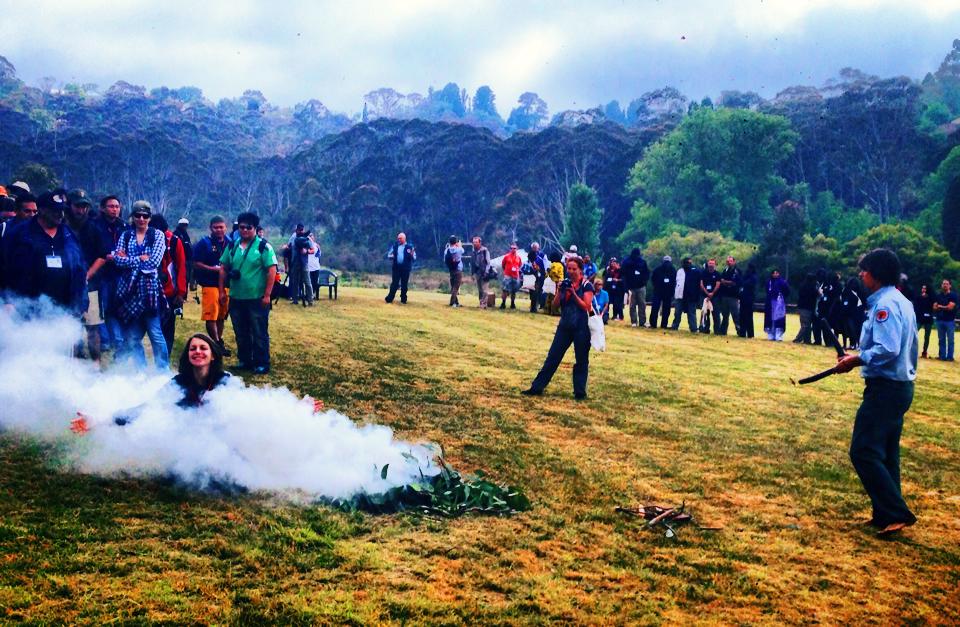 Smoking Ceremony or Smoke and Mirrors?
Staged for the delegates by National Parks and Wildlife Service of New South Wales (NPWS), somewhere outside Sydney, Australia
[Source: ‘Global First Nations environmentalists share stories at the World Parks Congress in Sydney.5:30’, ^https://twitter.com/nitvnews, 20141113] Smoking Ceremony or Smoke and Mirrors?
Staged for the delegates by National Parks and Wildlife Service of New South Wales (NPWS), somewhere outside Sydney, Australia
[Source: ‘Global First Nations environmentalists share stories at the World Parks Congress in Sydney.5:30’, ^https://twitter.com/nitvnews, 20141113]
.
Every ten years a World Parks Congress is a forum staged by the International Union for Conservation of Nature to discuss the effectiveness of World Heritage Listed Protected Areas. For 2014, Parks Australia put up Sydney’s hand to host and fund it.
<<“We (Parks Australia) are delighted to be co-hosting the IUCN World Parks Congress with our colleagues in the New South Wales National Parks and Wildlife Service – and look forward to welcoming inspiring leaders from around the world.”>>
IUCN’s vision is a “just world that values and conserves nature.” The theme for the 2014 conference is “Parks, people, planet: inspiring solutions”.
The last congress was in Durban, South Africa eleven years ago in 2003 and significant messages from that congress were that:
- Considerable progress has been made in the establishment of protected areas although significant gaps remain
- Protected areas face many challenges, and management effectiveness must be strengthened
- Protected areas play a vital role in biodiversity conservation and sustainable development
- A new deal is needed for protected areas, local communities and indigenous peoples
- There is a need to apply new and innovative approaches for protected areas, linked to broader agendas
- Protected areas require a significant boost in financial investment
- Protected areas management must involve young people
.
Congress Cost Benefits ?
.
The obvious first question for the 2014 Sydney Congress is what are the outcomes from these seven messages of 2003?
The second question is what is to be the conservation return on investment of staging the 2014 congress in Sydney? That starts with Parks Australia and NPWS disclosing the full costs of the congress. How much will it have cost by the time this week is over? Five million? Ten million? Twenty million? More? That also involves disclosure of the onground conservation outcomes, if any. The congress hosts more than 5000 delegates for a week-long event in Sydney.
If the answers are not forthcoming and/or the performances less than satisfactory, then perhaps the money could have been better spent (invested) by Parks Australia and NPWS on specific onground conservation of current and worthy Protected Areas in Australia. So the third question is what is the opportunity cost of the 2014 IUCN World Parks Congress which could have delivered the IUCN vision of a “just world that values and conserves nature”?
.
Congress Opportunity Costs
.
According to IUCN director general, Julia Marton-Lefevre, assessments during the past decade have found that half of the world’s protected areas at best — and possibly as few as 20 per cent — are managed effectively. “Some are what we refer to as ‘paper parks’ ” – parks just on paper.
The Australian Government’s $180 million allocation to expand the park reserve system expired last year.
The Great Barrier Reef Marine Park is a case in point. It is the iconic Protected Area in Australia. Its World Heritage listing along with various national zoning, management plans, permits, education and incentives are supposed to protect and conserve the marine ecosystems and migratory species from human threats. But farm and urban runoff continues to contaminate the rivers that flow into the Reef.
In 2009 and 2011, mining company Queensland Nickel discharged nitrogen-laden water and 516 tonnes of toxic waste water into the Great Barrier Reef.
On 21 July 2013, on the second day of the biennial joint training exercise Talisman Saber, two American AV-8B Harrier fighter jets launched from aircraft carrier USS Bonhomme Richard (LHD-6) dropped four bombs, weighing a total 1.8 metric tons (4,000 pounds), into more than 50 metres (164 ft) of water. On 3rd April 2010, The Shen Neng 1, a Chinese ship carrying 950 tonnes of oil, ran aground, causing the 2010 Great Barrier Reef oil spill.
In December 2013, Greg Hunt, the Australian environment minister, approved a plan for dredging to create three shipping terminals as part of the expansion of an existing coal port. According to corresponding approval documents, the process will create around 3 million cubic metres of dredged seabed that will be dumped within the Great Barrier Reef Marine Park.
On 31 January 2014, a permit was issued to allow three million cubic metres of sea bed from Abbot Point, north of Bowen, to be transported and unloaded in the waters of the Great Barrier Reef Marine Park, just outside of Abbot Bay. The dredge spoil will cloud the water and block sunlight, thereby starving sea grass and coral up to distances of 80 km away from the point of origin due to the actions of wind and currents. The dredge spoil will smother reef or sea grass to death, while storms can repeatedly resuspend these particles so that the harm caused is ongoing; secondly, disturbed sea floor can release toxic substances into the Great Barrier Reef Marine Park.
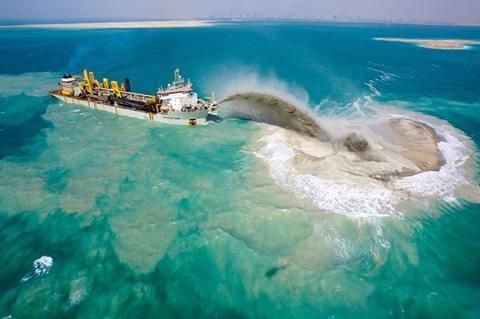 Dredging the Great Barrier Reef for bulk export shipping Dredging the Great Barrier Reef for bulk export shipping
.
The Great Barrier Reef Marine Park has become just a blue line on a map. The trickle of funds for Australia’s national parks betrays a lack of appreciation of their economic contribution. Annual funding for the authority that runs Australia’s most famous reserve, the Great Barrier Reef Marine Park, is about 1 per cent of the $5.2bn it earns the country in tourism revenue.
Yet if the IUCN World Parks Congress cost a conservative $20 million to stage then a key opportunity cost would be the June 2014 Federal budget cuts to the Great Barrier Reef Marine Park Authority.
The budget axed 17 staff including five of its’ directors positions. These positions included the director of heritage conservation, the director of policy and governance and the director of coastal ecosystems and water quality as part of an internal restructure. It’s being described as the greatest loss of expertise from Australia’s most important natural wonder and it comes at the very time the Great Barrier Reef is facing the greatest threat to its survival.
The Greater Barrier Reef Marine Park Authority has been reduced by the Australian Government to being in name only and ineffective at protecting the reef.
Until recently, one of those five directors, Adam Smith, was charged with dealing with the contentious Abbot Point coal terminal development and the proposal to dump three million cubic metres of dredge spoil into the marine park. Despite Dr Smith’s concerns, the sea dumping was approved by the Marine Park Authority.
Dr Smith has since accepted voluntary redundancy and moved on after disagreeing with the Authority’s new economic leadership and values. Heritage conservation director Jon Day has left after 21 years, disillusioned too with the direction the Authority has taken to compromise the reef.
Next year UNESCO will decide whether to put the reef on its world heritage in danger list. Native Dugongs are already endangered. The deliberate extermination of the dugong and turtles which habituated the Gladstone area is a national tragedy. Dugongs are species listed under the Federal Environment Protection Biodiversity & Conservation Act, which requires the Federal government to legally protect these animals.
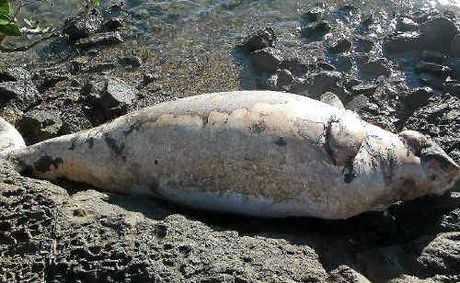
Prior to the massive dredging operation of 52 million cubic metres of seabed for the development of the world’s largest LNG Terminal, ( which is 62% completed) a study commissioned by the Gladstone Ports Corporation found that a take, or a quota, of more than zero dugongs would be unsustainable.
In the face of massive mortality of dugongs, turtles and inshore dolphins during the ongoing massive dredging, both the Federal and Queensland governments ignored the slaughter.
Look at the stranding data from the Queensland Department of Environment and Resource Management. Monthly cumulative Dugong strandings by year for Queensland, up to 31 January 2012.
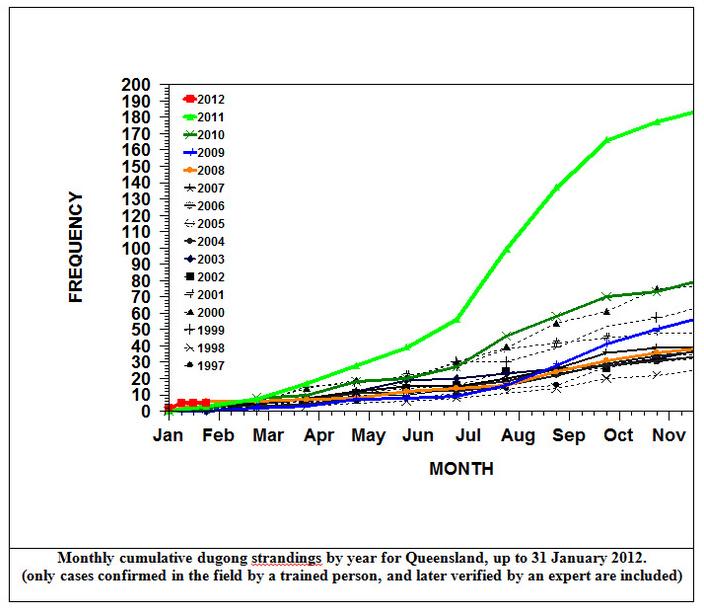
There are 22,000 vessel movements a month in Gladstone Harbour. No ship strikes of Dugongs or of Green Turtles need to be reported. No audit of environmental conditions has been undertaken by the Queensland or Federal Governments. The wholesale slaughter of our marine wildlife is the price Australians are paying for the transformation of the Great Barrier Reef World Heritage Area into the world’s largest unregulated quarry.
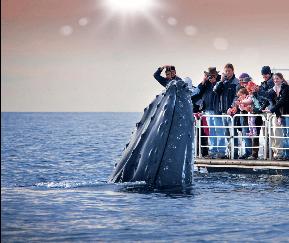 Mass tourism operators good for the economy
Getting up close to protected Humpback Whales within their 100 metre Protected Area Mass tourism operators good for the economy
Getting up close to protected Humpback Whales within their 100 metre Protected Area
.
Australian protected areas have seen rule changes in the eastern states have allowed cattle to graze, recreational shooters to hunt and hotel developers to build in national parks. Shore-based recreational fishing has been allowed in areas of NSW marine parks previously zoned as no-take sanctuaries. National parks on land and in the ocean are dying a death of a thousand cuts, in the form of bullets, hooks, hotels, logging concessions and grazing licences.
Yet as host of the 2014 World Parks Congress, Australia is showcasing “our own inspiring places, inspiring people and inspiring solutions.” The Global Eco Forum within the Congress programme focuses on tourism exploitation of Protected Areas because like the new Greater Barrier Reef Marine Park Authority, the new values are not about conservation by the billions in revenue opportunity to Australia’s economy.
The October 2006 issue of National Geographic published an article “The Future of Parks: Hallowed Ground – Nothing is Ever Safe”.
It stated:
“Landscape and memory combine to tell us certain places are special, sanctified by their extraordinary natural merits and by social consensus.
We call those places parks, and we take them for granted.”
.
Sydney’s 2014 World Parks Congress appears to be expensive window dressing, showcasing fraudulent conservation of Protected Areas in Australia.
It’s termed Greenwashing. The opportunity cost of the 2014 Congress could have instead funded the retention of the previously effective Great Barrier Reef Marine Park Authority and so done more for Protected Areas than all the pomp, promising, luncheons, showcasing, and talk-festing of the congress combined.
.
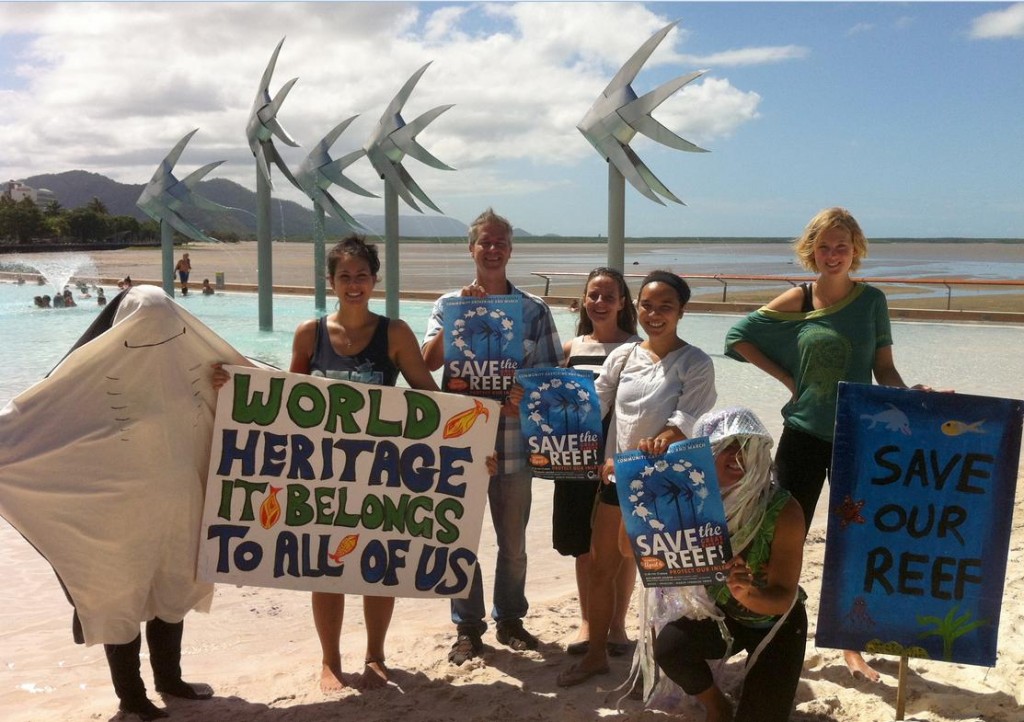 Protest to stop Queensland Resources Council dumping dredge spoil inside the Reef
Protest by Cairns and Far North Environment Centre (CAFNEC), June 2014
^http://cafnec.org.au/wp-content/uploads/2014/03/rally-promo-photo.jpg Protest to stop Queensland Resources Council dumping dredge spoil inside the Reef
Protest by Cairns and Far North Environment Centre (CAFNEC), June 2014
^http://cafnec.org.au/wp-content/uploads/2014/03/rally-promo-photo.jpg
.
Further Reading:
.
[1] IUCN World Parks Congress (Sydney 2014), International Union for Conservation of Nature, ^http://worldparkscongress.org/
.
[2] ‘Global Eco-Tourism in Protected Areas‘, by EcoTourism Australia, >2014 Global Eco Tourism in Protected Areas.pdf (1.1MB, 2 pages)
.
[3] Great Barrier Reef Marine Park Authority (website), Australian Government, ^http://www.gbrmpa.gov.au/
.
[4] Fight for The Reef (website), Australian Marine Conservation Society, ^https://fightforthereef.org.au/risks/dredging/
.
[5] No Hunting in National Parks (website), The National Parks Association of NSW, ^http://nohunting.wildwalks.com/
.
[6] ‘An international perspective on tourism in national parks and protected areas‘, by J.G. Castley (2014), >An international perspective on tourism in national parks and protected areas.pdf (100kb, 10 pages)
.
[7] ‘EXTRA: ‘Nasho’, Royal National Park, Sydney’s neglected southern jewel‘, by Nick Galvin, Journalist, Sydney Morning Herald, 20140613, ^http://www.smh.com.au/nsw/extra-nasho-royal-national-park-sydneys-neglected-southern-jewel-20140613-zs6d8.html
.
[8] ‘Paradise lost: Australia’s heritage jewels under threat‘, (audio), ABC ‘Background Briefing’ radio programme, by Sarah Dingle, 20131208, ^http://www.abc.net.au/radionational/programs/backgroundbriefing/2013-12-08/5132224
.
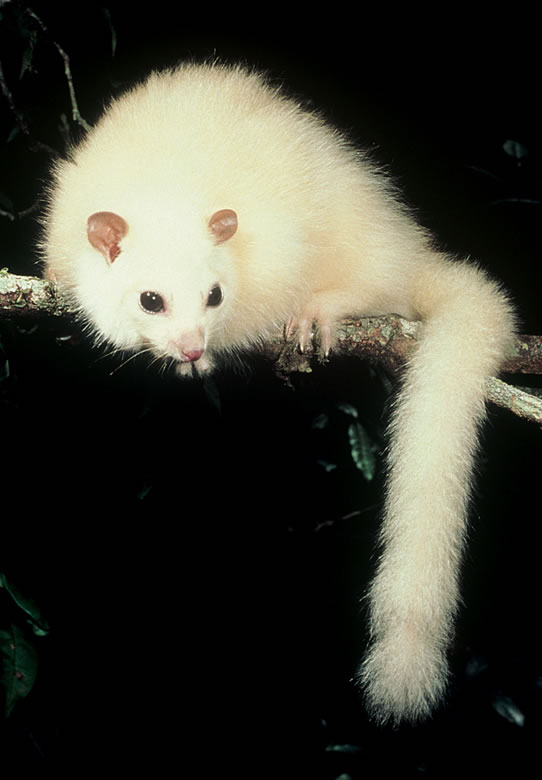 White Lemuroid Possum
(Wet Tropics of Queensland World Heritage Area in Danger)
Has the white lemuroid possum become the first mammal to go extinct due to global warming? White Lemuroid Possum
(Wet Tropics of Queensland World Heritage Area in Danger)
Has the white lemuroid possum become the first mammal to go extinct due to global warming?
The species, normally found above 1000m, has not been sighted during any nighttime spotlighting expedition since 2005. Experts fear a temperature rise of 0.8 degrees Celsius may be to blame for the animal’s disappearance.
[Source: ^http://www.wherelightmeetsdark.com/index.php?module=newswatch&NW_user_op=view&NW_id=453]
.
Tags: Dugong, Dugong strandings, Gladstone Harbour, Great Barrier Reef, Great Barrier Reef Marine Park, Green Turtle strandings, greenwashing, Humpback Whale, International Union for Conservation of Nature, iucn, national parks, National Parks and Wildlife Service, Parks Australia, Protected Areas in Australia, Queensland Government, The Great Barrier Reef Marine Park Authority, UNESCO world heritage in danger list, Wet Tropics of Queensland World Heritage Area in Danger, White Lemuroid Possum, World Heritage, World Parks Congress
Posted in Critically Endangered Wildlife (CR), Threats from Government Funding Neglect, Threats from Greenwashing, Threats from Pollution, Threats from Tourism and Recreation, Threats from Weak Environmental Laws | No Comments »
Add this post to Del.icio.us - Digg
Friday, November 2nd, 2012
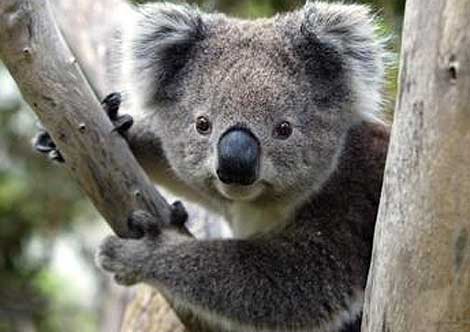 Once were common – now pose for the commoner! Once were common – now pose for the commoner!
Australia’s Koala
(Phascolarctos cinereus)
.
Australia’s iconic and once prolific Koala is now nationally listed as vulnerable to extinction.
What a despicable indictment of Australians!
<<The Koala was formerly common throughout the broad band of forests and woodlands dominated by Eucalyptus spp. extending from north Queensland to the south-eastern corner of mainland South Australia, Australia (Maxwell et al. 1996). However, the overall distribution of Koalas has been reduced since European settlement. This decline was primarily due to disease, bushfires, and widespread habitat destruction in the early decades of the 20th century.
Commercial poaching of koalas (they called it ‘harvesting‘) took place across the range towards the end of the 19th century and early 20th century (huge numbers, running into the millions, were killed for their pelts for a large export industry in Victoria, New South Wales, and Queensland). Koalas were widely hunted during the 1920s and 1930s, and their populations plunged.>>
Backward Queensland was the worst offender. In August 1927, the Koala fur trade saw the Queensland Government declare ‘open season’ on Koalas. Some 600, 000 koalas were shot to make gloves and hats in jut one month. It became known as ‘Black August‘.
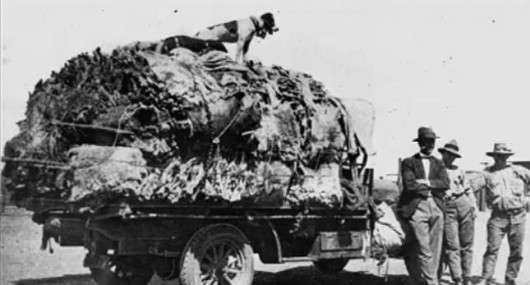 1927 ‘Black August’
When 600,000 Koalas were shot and skinned across Queensland
1927 ‘Black August’
When 600,000 Koalas were shot and skinned across Queensland
.
Commercial hunting was banned in Victoria in the 1890s, yet it continued sporadically (and under regulation) in backward Queensland until 1927 (Hrdina and Gordon 2004).

<<The Koala currently ranges from northeastern, central, and southeastern Queensland with patchy populations in western areas, to eastern New South Wales including the coastal strip and highlands of the Great Dividing Range, the western plains and related riparian environments where suitable habitat occurs, Victoria, and southeastern South Australia. The geographic range has contracted significantly due to loss of large areas of habitat since European settlement. In Queensland, extent of occurrence and area of occupancy have contracted by about 30% (Gordon et al. 2006).
Helped by reintroduction, Koalas have reappeared over much of their former range, but their populations are smaller and scattered. Koalas need a lot of space—about a hundred trees per animal—a pressing problem as Australia’s woodlands continue to shrink.>>
[Sources: The IUCN Red List of Threatened Species – Phascolarctos cinereus (Koala), ^http://www.iucnredlist.org/details/16892/0 ; ‘Koala’, National Geographic, ^http://animals.nationalgeographic.com/animals/mammals/koala/]
.
(2.6MB, pdf – NB. if slow to open, GoTo: File > Save As.., then open the PDF file from your auto-download folder)
.
[Source: The Decline in the distribution of the Koala in Queensland, G. Gordon, F. Hrdina, R. Patterson, Zoologist Vol 33, 2004,^http://www.rzsnsw.org.au/]
.
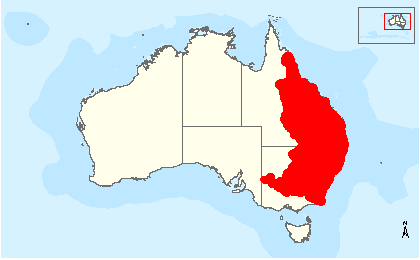 Koala Traditional Natural Range map (excluding Victorian and South Australia) Koala Traditional Natural Range map (excluding Victorian and South Australia)
[Source: ‘Koala (combined populations of Queensland, New South Wales and the Australian Capital Territory), Australian Government,
^http://www.environment.gov.au/cgi-bin/sprat/public/publicspecies.pl?taxon_id=85104]
.
<<Since European settlement, approximately 80% of Australia’s eucalypt forests have been decimated. Of the remaining 20% almost none is protected and most occurs on privately-owned land.>>
[Australian Koala Foundation, ^https://www.savethekoala.com/our-work/land-clearing-koalas]
.
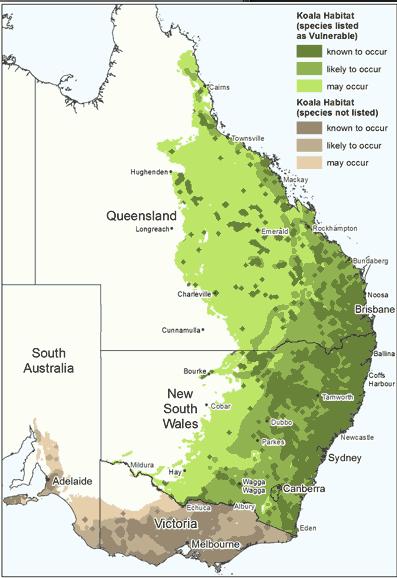 Koala reduced range map Koala reduced range map
Ed: Interpretation is Dark Green = known to occur, Light and Mid Green = used to occur
Dark green is where human population growth is worst!
(Source: ‘Koala (Phascolarctos cinereus) Listing’, Australian Government, 2012),
^http://www.environment.gov.au/biodiversity/threatened/species/koala.html]
.
.
Koalas partially listed as ‘Vulnerable’ to extinction
.
In April 2012, Australia’s Environment Minister, Tony Burke, declared that ‘at-risk’ koala populations along Australia’s eastern seaboard ‘vulnerable‘ under Australian national environment law – specifically under the Environment Protection and Biodiversity Conservation Act 1999.
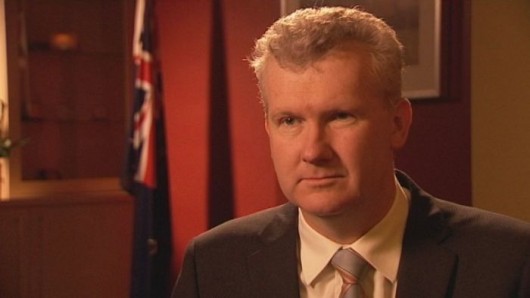 Australia’s Environment Minister, Tony Burke
Being interviewed on ABC Four Corners 20120821
[Source: ‘Koala Crunch Time’, ABC Four Corners, 20120821,^http://www.abc.net.au/4corners/stories/2012/08/16/3569231.htm] Australia’s Environment Minister, Tony Burke
Being interviewed on ABC Four Corners 20120821
[Source: ‘Koala Crunch Time’, ABC Four Corners, 20120821,^http://www.abc.net.au/4corners/stories/2012/08/16/3569231.htm]
.
This ‘EPBC Act‘ remains the Australian Government’s central piece of environmental legislation, providing a legal framework to protect and manage nationally and internationally important flora, fauna, ecological communities and heritage places. The Australian Government’s Department of Environment (etc) is currently developing EPBC Act referral guidelines for the Koala.
[Source: Australian Government, ^http://www.environment.gov.au/epbc/publications/interim-koala-referral-advice.html]
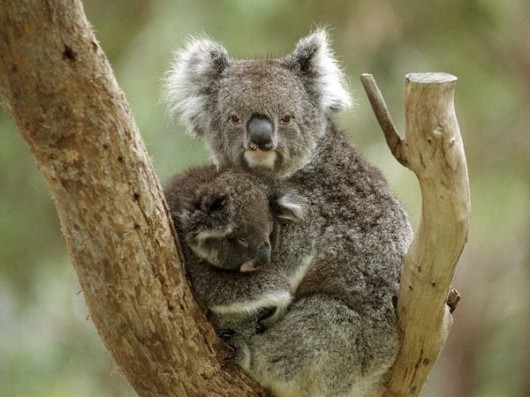 Koala with joey – zoo captive to benefit tourist visitation Koala with joey – zoo captive to benefit tourist visitation
[Source: Photo by Medford Taylor, National Geographic,
^http://animals.nationalgeographic.com/animals/mammals/koala/]
.
<<Rigorous scientific assessment by a variety of experts over the past three years has been reported back to Australia’s lead body on biodiversity conservation, the Threatened Species Scientific Committee (TSSC), which has found that Koala populations particularly in Queensland, New South Wales and Australian Capital Territory have declined markedly in recent years to a point where in these areas populations are vulnerable to regional extinction.
In 2011, the Threatened Species Scientific Committee combined available data for Koala populations across their natural range and generated estimates of the decline experienced over the period 1990–2010 by the national Koala population and, separately, the combined Queensland, NSW and ACT population (TSSC 2011bi).
The parameters of greatest uncertainty are the size of the Queensland population in 1990 and rate of subsequent decline, particularly in inland bioregions, and the size of the Victorian population.>>
The following table is a summary of the TSSC assessment of national Koala populations (TSSC 2012p):
| Region |
Date |
Best estimate |
Decline |
| Queensland |
1990 |
295 000 |
|
| 2010 |
167 000 |
43% |
| New South Wales |
1990 |
31 400 |
|
| 2010 |
21 000 |
33% |
| Victoria |
1990 |
215 000 |
|
| 2010 |
200 000 |
7% |
| South Australia |
1990 |
32 000 |
|
| 2010 |
19 500 |
39% |
TSSC 2012 Assessment of National Koala Populations
[Source: Koala (combined populations of Queensland, New South Wales and the Australian Capital Territory), Species Profile and Threats Database, Australia Government, ^http://www.environment.gov.au/cgi-bin/sprat/public/publicspecies.pl?taxon_id=85104]
.
<<These are the same regions where rapid ongoing housing development is allowed and encouraged, as Australia’s human population expands uncontrollably.
Mr Burke said “Koala populations are under serious threat from habitat loss and urban expansion, as well as vehicle strikes, dog attacks, and disease…In fact, in some areas in Victoria and South Australia, koalas are eating themselves out of suitable foraging habitat and their numbers need to be managed.”
“That is why the Scientific Committee recommended to me to list the Queensland, New South Wales and Australian Capital Territory populations as threatened, rather than to list the koala as nationally threatened across its full range.”
Mr Burke said the Gillard Government had committed $300,000 of new funding under the National Environmental Research Program Emerging Priorities to find out more about koala habitat.
“This funding will be used to develop new survey methods that will improve our knowledge of the quality of koala habitat using remote sensing, and help fill important data gaps to enhance our understanding and ability to protect the species,” Mr Burke said.
“The new funding is in addition to more than $3 million we have invested since 2007 to ensure the resilience and sustainability of our koala population.”>>
[Source: ‘Koala protected under national environment law’, The Hon Tony Burke MP media release, Minister for Environment etc, 20120430, ^http://www.environment.gov.au/minister/burke/2012/mr20120430.html]
.
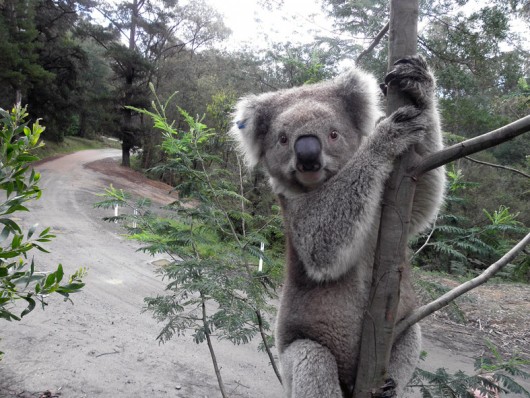 Koalas reduced to patchy populations
Below the IUCN radar/crisis, Koala functional extinction looms
… patchy populations, and more patchy every year.
Do we wait until Koala numbers downgrade to ‘Critically Endangered‘ before the Australian Government gives a toss! Koalas reduced to patchy populations
Below the IUCN radar/crisis, Koala functional extinction looms
… patchy populations, and more patchy every year.
Do we wait until Koala numbers downgrade to ‘Critically Endangered‘ before the Australian Government gives a toss!
[Source: ^http://home.vicnet.net.au/~fofkk/]
.
.
Australian Government – too little, too late, too selective
.
<<But the Australian Government’s announcement (back in April 2012, now six months ago) only confirmed what the Lismore-based ‘Friends of the Koala‘ group has known for more than a decade. Friends of the Koala volunteer carer Lola Whitney said the listing was long overdue.
“The work that we do here tells us that koalas are in danger of becoming extinct,” she said. “So many koalas come through our care centre every year, that it’s amazing we’ve got any around here at all. And the amount we lose from being hurt or from diseases – we lose a lot.”>>
.
Ed: But the Australian Government has only partially listed Koalas as vulnerable to extinction in Queensland, New South Wales and the Australian Capital Territory (ACT). Whereas Victorian and South Australian koalas were omitted.
.
This was because these were the recommendations of the 2011 Senate Enquiry, despite the TSSC confirmed 39% decline in the South Australian Koala population between 1990 and 2010.
.
Tony Burke as ultimate custodian: Why were problematic declining Koalas across South Australia and Victoria excluded from the EPBC Act?
.
It was also because the lead authority, the Threatened Species Scientific Committee, had “information gaps”, and because “the body of data on the status of koala populations is patchy, often sparse and not nationally comprehensive or coordinated”, the TSSC ignored the ‘Precautionary Principle and repeatedly rejected the Koala’s threatened species listing on the EPBC Act.
.
What it failed to appreciate was the more appropriate IUCN Red List categories of ‘DATA DEFICIENT’ (DD) and ‘NOT EVALUATED’ (NE).
.
.
The Conclusion by the 2011 Senate Committee Enquiry was selective. It read as follows:
.
<<The most prominent issue raised during this inquiry was whether the koala should be listed as a threatened species. Although the committee does not have the technical expertise of the TSSC, and therefore believes it is not qualified to determine whether or not the koala should be listed as threatened, the committee is deeply concerned about the sustainability of Australia’s koala population.
On one hand, the committee is pleased that the koala may not yet be eligible for listing as threatened. The committee believes that to have such a significant Australian icon
included on the threatened species list would be a national shame.
On the other hand, the committee believes there are parts of the koala population that require much greater protection. This is occurring to some extent in Queensland and NSW where the koala is listed in some areas under state environment protection legislation. However, state listing has not stemmed the marked decline in the population. If declines continue it will only be a matter of time before the koala is nationally listed as a threatened species.
The EPBC threatened species listing process is reactive and not well suited to the conservation needs of the koala. In the committee’s view, there ought to be processes available to enable proactive protection for the koala as well as other significant Australian species. In this regard the committee notes the possible mechanisms announced as part of the government’s response to the review of the EPBC Act which could enable a more proactive approach to koala conservation. Perhaps, building on the TSSC’s proposal to monitor species of cultural, evolutionary and/or economic significance, there ought to be a category of nationally significant species.
Ultimately, the committee would like to see Australia’s koala population return to plentiful numbers of healthy individuals, in resilient habitats, across the koala’s natural range.>>
[Conclusion, p. xix]
.
Threatened Species Scientific Committee repeatedly rejected Koala listing on EPBC Act
.
Three separate Listing Advices by the ‘ by the Threatened Species Scientific Committee (TSSC) to successive Australian Environment Ministers rejected the listing of the Koala as a threatened species on the EPBC Act, as follows:.
.
Feb 2006:
.
Due to the TSSC acknowledging that “there are still information gaps regarding the species’ conservation status“, the TSSC recommendation to Australia’s Environment Minister on Koala conservation was:
“The Committee recommends that the species Phascolarctos cinereus (Koala) is not eligible for inclusion in the list referred to in section 178 (Listing of Threatened Species) of the EPBC Act.”
[Source: ‘Advice to the Minister for the Environment and Heritage from the Threatened Species Scientific Committee (the Committee) on Amendments to the list of Threatened Species
under the EPBC Act’, 20060206, Item 6, p.15, Threatened Species Scientific Committee,^http://www.environment.gov.au/biodiversity/threatened/species/pubs/koala.pdf, >Read 2006 Listing Advice]
.
Sep 2010:
.
<<The body of data on the status of koala populations is patchy, often sparse and not nationally comprehensive or coordinated. The data quality is also variable. There has been only limited improvement in quality, relevance and integration of these data over the 15 years that the koala has been considered by this Committee and its predecessor. This situation is not unusual for the Committee but what is unusual is the huge area of occurrence and variability that the koala demonstrates. I addition there is a lack of any consistent reliable methodology for population monitoring of the koala.>>
.
<<In its deliberations, the Committee concluded that a Conservation Dependent listing for the koala could not be justified at this time.>>
.
[Source: Letter to Minster for Environment, by Associate Professor Robert J.S. Beeton, Chair, Threatened Species Scientific Committee, 20100930 ^http://www.environment.gov.au/biodiversity/threatened/species/pubs/koala-tssc-letter.pdf, >Read Sep 2010 Letter]
.
Feb 2011:
.
<<The Committee recommends that the list referred to in section 178 of the EPBC Act not be amended at this time by including the Phascolarctos cinereus (koala) in the list in the Vulnerable category.>>
.
[Source: ‘Advice to the Minister for Environment Protection, Heritage and the Arts from the Threatened Species Scientific Committee (the Committee) on Amendment to the list of Threatened Species under EPBC Act’, 20110211, Item 12, p.29, Threatened Species Scientific Committee,^http://www.environment.gov.au/biodiversity/threatened/species/pubs/koala-listing-advice.pdf, >Read Feb 2011 Listing Advice ]
.
Nov 2011 (change of heart, but ignoring Victoria and South Australia):
.
<<12. Recommendations
(i) The Committee recommends that the Minister declare the combined koala (Phascolarctos cinereus) populations in Queensland, New South Wales and the Australian Capital Territory to be a species for the purposes of the EPBC Act under s517 of the Act.
(ii) The Committee recommends that the list referred to in section 178 of the EPBC Act not be amended by including the koala (Phascolarctos cinereus) over its national extent.
(iii) The Committee recommends that the list referred to in section 178 of the EPBC Act be amended by including in the list in the Vulnerable category the combined koala (Phascolarctos cinereus) populations in Queensland, New South Wales and the Australian Capital Territory.
(iv) The Committee recommends that there should be a recovery plan for this species.>>
.
[Source: ‘Advice to the Minister for Sustainability, Environment, Water, Population and Communities from the Threatened Species Scientific Committee (the Committee) on Amendment to the list of Threatened Species under the EPBC Act, 20111125, Item 12, p.34, Threatened Species Scientific Committee,^http://www.environment.gov.au/biodiversity/threatened/species/pubs/197-listing-advice.pdf, >Read Nov 2011 Listing Advice ]
.
The current members of the Threatened Species Scientific Committee are:
.
- Professor Helene Marsh (Chair)
- Dr Guy Fitzhardinge
- Dr Gordon Guymer
- Professor Peter Harrison
- Dr Rosemary Purdie
- Dr Keith Walker
- Professor John Woinarski
- Dr Andrea Taylor
- Dr William Humphreys
- Dr Michelle Heupel
.
[Source: ‘Threatened Species Scientific Committee Members, Department of Environment (etc, Australian Govermment, ^http://www.environment.gov.au/biodiversity/threatened/committee-members.html]
 Professor Helen Marsh
TSSC Chair since August 2011 Professor Helen Marsh
TSSC Chair since August 2011
.
To his credit, Tony Burke had asked the Threatened Species Scientific Committee (TSSC) for more precise boundaries detailing areas where koala populations are in trouble.
In February 2012, Australian Koala Foundation chief executive officer Deborah Tabart said that this Senate Committee Enquiry document was telling Mr Burke that he should act now and not wait another 10 weeks.
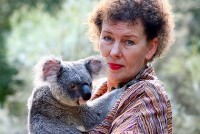 Deborah Tabart OAM
– not smiling Deborah Tabart OAM
– not smiling
.
<<“Minister Burke has delayed this decision, I think, twice and Minister (Peter) Garrett prior to that, I think, three times. “I’m just hoping that the Senate inquiry document, which is now firmly on his (Mr Burke’s) desk, should persuade him that, if nothing else, he should protect the koala under a precautionary approach”, said Tabart.>>
[Source: ‘Government ‘stalling’ on endangered koalas decision’, Feb 17, 2012, ^http://www.abc.net.au/news/2012-02-17/koala-listing-process-delayed/3835228 ]
.
[Source: Australian Parliament House, Senate Committees, >’The koala—saving our national icon’, 20110922, ^http://www.aph.gov.au/Parliamentary_Business/Committees/Senate_Committees?url=ec_ctte/koalas/report/index.htm]
.
<<The National Board of the Australian Koala Foundation (AKF), being much more aware of the Koala population range reality, undertook an extensive mapping project to quantify how many koalas remained in the wild, and where those koalas were located.
Extensive research was undertaken using National Vegetation Information System (NVIS) data, vegetation mapping, a bidling database of records for over 80,000 individually assessed trees from 2,000 field sites across the Koala’s range. Data has been collected by AKF from sixteen of the twenty-four Australian bioregions that the Koala is known to occur.>>
In 2011, the following map has been prepared estimating Australia’ national Koala population:
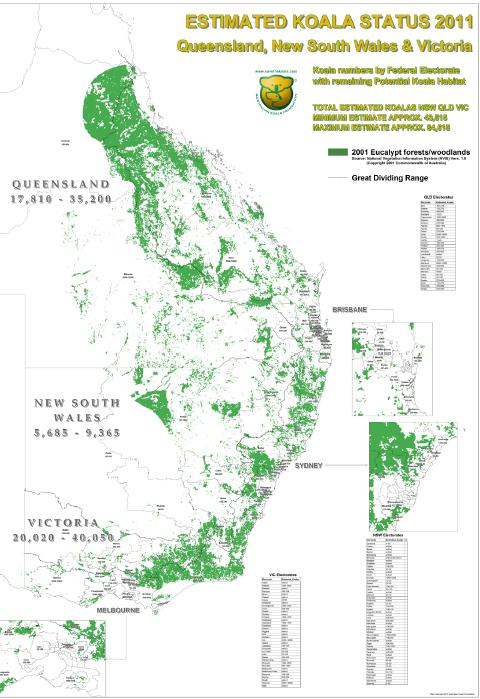 Estimated Australian Koala Population, 2011 Estimated Australian Koala Population, 2011
>Read Large Map(pdf) (3.4MB – – NB. if slow to open,
GoTo: File > Save As.., then open the PDF file from your auto-download folder)
[Source: ‘Bob’s Map’, Australian Koala Foundation,
^https://www.savethekoala.com/our-work/koala-numbers]
.
2011 Senate Committee: ‘The koala—saving our national icon’
.
The 19 Recommendations of the Senate Committee
.
<<Recommendation 1
The Australian Government fund research into the genetic diversity of the koala including a population viability assessment of the southern koala and determining priority areas for conservation nationally.
.
Recommendation 2
The Australian Government fund a properly designed, funded and implemented national koala monitoring and evaluation program across the full range of the koala.
.
Recommendation 3
The Australian Government establish a nationally coordinated and integrated program for population monitoring of threatened species and other culturally, evolutionary and/or economically significant species.
.
Recommendation 4
The Australian Government assist the koala research community and interested organisations to work towards a standardised set of methodologies for estimating koala populations.
.
Recommendation 5
The Threatened Species Scientific Committee provide clearer information to the Environment Minister in all future threatened species listing advices, including species population information, and that the Threatened Species Scientific Committee review its advice to the Minister on the listing of the koala in light of the findings of this inquiry.
.
Recommendation 6
The Australian Government undertake habitat mapping across the koala’s national range, including the identification of priority areas of koala conservation, with a view to listing important habitat under the provisions of the EPBC Act.
.
Recommendation 7
The habitat maps be used to identify and protect important habitat in known koala ranges.
.
Recommendation 8
The Australian Government review its land holdings which contain koala habitat and consider biodiversity, and specifically koala populations, in the management and sale of Commonwealth land.
.
Recommendation 9
The Australian Government actively consider options for recognition and funding for private land holders for the conservation of koala habitat.
.
Recommendation 10
The Australian Government fund research into koala disease, including the viability of vaccination programs and the effect of changes in leaf chemistry.
.
Recommendation 11
The Australian Government fund the Koala Research Network’s request for a Research Liaison Officer.
.
Recommendation 12
The Australia Government consider further wild dog control options in priority koala areas.
.
Recommendation 13
Local and state governments:
- Introduce appropriate speed limits in priority koala areas; and
- Where appropriate, build or retrofit underpasses or overpasses for major roads in priority koala areas as well as installing koala fencing adjacent to major roads.
.
Recommendation 14
Where the Australian Government provides funding for roads or other infrastructure in or adjacent to koala habitat, it be contingent on the provision of adequate koala protections.
.
Recommendation 15
The Australian Government work with the states to develop new national guidelines to ensure that all new roads and upgrades in or adjacent to koala habitat are koala-friendly.
.
Recommendation 16
The (Australian Government’s) Environment Minister consider the evidence provided to this inquiry when making his final decision on listing the koala as a threatened species.
.
Recommendation 17
The (Australian Government’s) Environment Minister consider options to improve the conservation status of the diverse and rapidly declining koala populations in New South Wales and Queensland to ensure a nationally resilient population is maintained. These options include listing the koala as vulnerable under the EPBC Act in areas where populations have declined significantly or are at risk of doing so.
.
Recommendation 18
An independent external review be conducted on the National Koala Conservation and Management Strategy to monitor the adequacy of progress. The review should assess and report on the progress made at the strategy’s midpoint.
.
The review must include an assessment of the:
- Strategy’s implementation to date and prospects into the future;
- Strategy’s effectiveness in stabilising koala numbers in areas of declining population, and in reducing the pressure of overabundant populations;
- Strategy’s level of ambition, including whether new elements are required; and
- Adequacy of the Commonwealth’s and the states’ respective roles and funding commitments.
.
Recommendation 19
The Australian Government adequately resource the National Koala Conservation and Management Strategy, and ensure that it is properly implemented through committing to a much stronger leadership role.>>
.
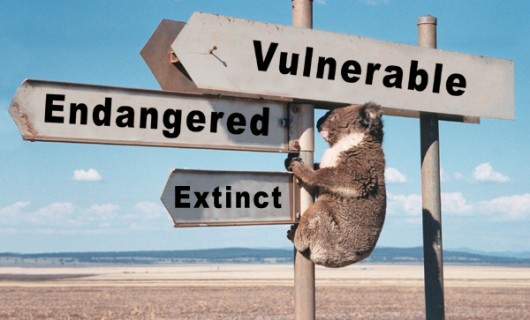 . .
.
Of note, ‘Recommendation 17‘ restricted the conservation status of the Koala only to ensure a ‘nationally resilient population is maintained’. That means that regional extinctions shall be acceptable, so long as a ‘nationally resilient population is maintained’ somewhere.
These are the places that the Koala is deemed to be declining and so given the vulnerable status. Other Koala populations elsewhere don’t weem to matter to the Australian Government.
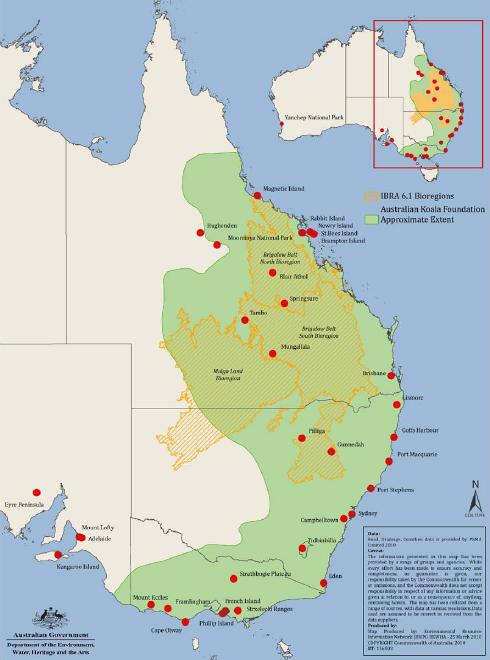 Koala tokenly listed as ‘Vulnerable’ but politically only at the above ‘selected places’
under the Environment Protection and Biodiversity Conservation Act (1999) Koala tokenly listed as ‘Vulnerable’ but politically only at the above ‘selected places’
under the Environment Protection and Biodiversity Conservation Act (1999)
.
.
2000: Even then, the United States recognised Koalas as ‘Vulnerable’
.
<<Back on 9th May 2000, the United States Government listed all koalas in Australia as vulnerable under the Endangered Species Act. The US Government determined that a) the eucalyptus and woodland ecosystems on which the arboreal marsupial depends has been greatly reduced, b) that despite conservation action by the governments of Australia, koala habitat continues to deteriorate, and c) that irrespective of koala numbers, the threats were present and real.
At the time, the Australian Government was outraged. The Australian Koala Foundation considered that the US may have been pointing out to Australia (when President Clinton and Vice President Al Gore were in power) that Australia needed to control its land clearing in readiness for the Kyoto Protocol on climate change. One petitioner pointed out that Australia at that time was clearing land second only to the Amazon.
At the time, the Victorian Government was pleading that they ‘had so many koalas they are pests’, and a similar cry was heard in the 2011 Senate Committee Enquiry into the plight of the Koala.
Australian Greens Leader, Senator Bob Brown had in 2010 successfully moved for a new Senate Comittee Enquiry to assess the threats to and management of koalas across the country. The Inquiry into the status, health and sustainability of Australia’s koala population, has particular reference to:
- the iconic status of the koala and the history of its management;
- estimates of koala populations and the adequacy of current counting methods;
- knowledge of koala habitat; d. threats to koala habitat such as logging, land clearing, poor management, attacks from feral and domestic animals, disease, roads and urban development;
- the listing of the koala under the Environment Protection and Biodiversity Conservation Act 1999;
- the adequacy of the National Koala Conservation and Management Strategy;
- appropriate future regulation for the protection of koala habitat;
- interaction of state and federal laws and regulations; and i. any other related matters.
.
Environment Minister Tony Burke appears to have been swayed by this plea as unlike his United States counterparts he did not consider the following in the American citation “…the actual number of koalas that were present at various times in the past and that may still exist is of much interest and helps to give some perspective but, as for many species, may not be the critical factor in determining whether the species is threatened. A low figure may reflect natural rarity of a population in marginal habitats. A high figure may be misleading if the entire habitat of the involved population faces imminent destruction”.
The document continues “…if we receive strong biological arguments, we would consider giving separate consideration to particular populations. It should be recognised, however, that koalas cannot be considered separate populations solely because they reside in different state jurisdictions”.
No such biological argument could be made. On the contrary, genetic studies in Victoria show that by and large all Victorian koalas, except those in the eastern part, are all pretty much genetically identical which means the future is bleak for conservation. Some of them even have testicles missing. On Kangaroo Island, some research suggests that as many as 29 per cent may have this affliction.
Imagine a koala that lives on the Murray River in New South Wales. On one side of the river, it has protection, but if it swims to Victoria, it does not. In AKF’s view, either the Australian Government values our national icon for its contribution to our nation or it does not.
As seen on Four Corners last night, the fur trade decimated the koala and the remnant populations are still low as a result of that slaughter.
Nowadays, the Koala pays its way in big tourism dollars, not the paltry one shilling (around 10 cents) per skin.
.
‘But the koala has powerful enemies. In the senate inquiry, developers, loggers, bureaucrats and even some departments of environment pleaded with the senators not to list the Koala because it would upset the developers or impede growth.’
.
The partial listing of the koala as vulnerable in NSW, ACT and Queensland can be seen as some sort of win, but will the existing legislation (the EPBC Act) be strong enough to protect the koala from long term destruction of its habitat?
Although the animal itself has been protected since 1936, its habitat really has not.
The Australian Koala Foundation believes its future lies in a koala-specific legislation similar to that of the American Bald Eagle Act, enacted in 1942. The Americans realised that if they did not do something strong and powerful they might lose their national icon forever. We believe that time has come now. The AKF estimates there may be as few a 43,000 koalas with no more than 85,000 left in its original habitat. If we are right, then there is no time to waste.
Greens Senator Bob Brown, as a final gesture before leaving Parliament, said he would support the AKF in our endeavours to enact a Koala Protection Bill. This should be a simple piece of legislation that basically says if you have koalas on your property that you cannot harm them, remove their trees and must – and that is the operative word – must ensure that your activity is benign for their long term future.
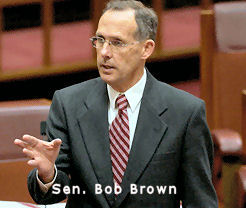
Four Corners has identified real threats to the koala and a partial listing will probably not make them go away. Neither will a specific piece of legislation, unless all our politicians actually realise we are at real risk of losing them.’>>
[Source: ‘Koalas deserve full protection‘, by Deborah Tabart, Chief Executive of the Australian Koala Foundation, 20120821, ABC, ^http://www.abc.net.au/environment/articles/2012/08/21/3571830.htm ; https://www.savethekoala.com/about-us/news-events/senate-inquiry]
.
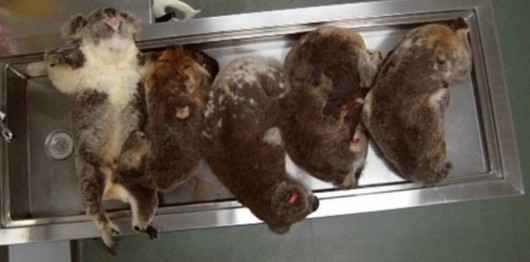 Dead Koalas on a vet’s autopsy table – with all the Green Talk how has it come to this?
Dead Koalas on a vet’s autopsy table – with all the Green Talk how has it come to this?
A native species that just sits up a tree, sleeps and hurts no-one
..now dying out because of Australian selfish viciousness.
Koalas are dying or being euthanised by the hundreds as a result of dog predation, road carnage, and Koala Habitat destruction.
[Source: ‘Koala Crunch Time’, ABC Four Corners (television programme), 20120821,
^http://www.abc.net.au/4corners/stories/2012/08/16/3569231.htm]
.
Watch ABC Four Corners Programme: ‘Koala Crunch Time‘
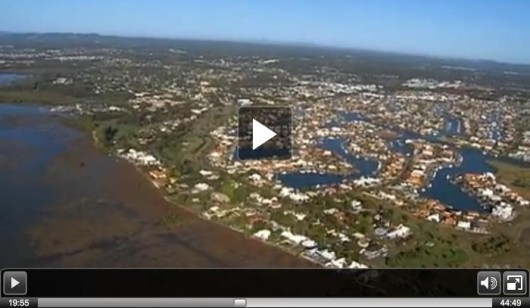 Australia’s Sprawl Profit overrules Biodiversity
‘Since 1997, koala hospitals along Australia’s eastern seaboard have recorded 15,000 Koala deaths’
[Source: Koala Crunch Time’, ABC Four Corners,^http://www.abc.net.au/4corners/stories/2012/08/16/3569231.htm] Australia’s Sprawl Profit overrules Biodiversity
‘Since 1997, koala hospitals along Australia’s eastern seaboard have recorded 15,000 Koala deaths’
[Source: Koala Crunch Time’, ABC Four Corners,^http://www.abc.net.au/4corners/stories/2012/08/16/3569231.htm]
.
 Westfield Shopping Centre development profiting out of Koala habitat apocalypse
Low (economic) Cost Housing, Coomera, Queensland Westfield Shopping Centre development profiting out of Koala habitat apocalypse
Low (economic) Cost Housing, Coomera, Queensland
.
.
IUCN wrongly continues to list Koalas as of ‘Least Concern’
.
Although Koala’s only exist naturally in Australia, at the international level the Koala (Phascolarctos cinereus) is still officially listed as of ‘Least Concern‘.
The most recent survey count of Koala status obtained by The International Union for Conservation of Nature (IUCN), the lead global authority on the environment and sustainable development, was back in 2008. Why, when the rapid decline data has been out since 2010?

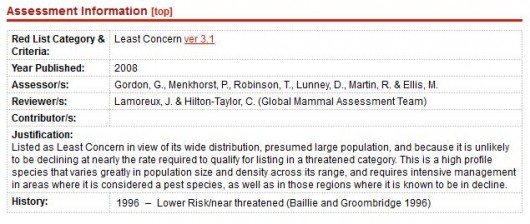 Phascolarctos cinereus (Koala)
The International Union for Conservation of Nature Red List of Threatened Species,
^http://www.iucnredlist.org/details/16892/0] Phascolarctos cinereus (Koala)
The International Union for Conservation of Nature Red List of Threatened Species,
^http://www.iucnredlist.org/details/16892/0]
.
The IUCN then assessed the Koala as having a ‘wide distribution’ and ‘a presumed large population’. It ignored regional declines and only regarded the national aggregate as appropriate data. Worse is that it stated thay the Koala “requires intensive management in areas where it is considered a pest species“.
Ed: What ecological incompetence, and wildlife hate would assess wildlife as a pest species?
.
The IUCN recognised that the Koala population was in decline in certain areas and identifed the following threats to the species:
- Continued habitat destruction, fragmentation, and modification (which makes them vulnerable to predation by dogs, vehicle strikes, and other factors)
- Bushfires
- Disease
- Drought associated mortality in habitat fragments
.
[Source: The IUCN Red List of Threatened Species – Phascolarctos cinereus (Koala), ^http://www.iucnredlist.org/details/16892/0]
.
Koala loss is symptomatic of Australia’s loss of much of the country’s native wildlife, its ecological communities and its biodiversity.
<<As of February 2011, a total of 1777 species are listed as threatened under the Environment Protection and Biodiversity Conservation Act (EPBC Act). A further 210 migratory and 464 marine species are also listed. The EPBC Act also lists 48 ecological communities as being threatened. These communities occur in a range of ecosystems including woodlands, forests, grasslands and wetlands.
Current threats to Australia’s biodiversity are:
- Habitat loss
- Degradation and fragmentation
- Invasive species and diseases
- Unsustainable use and management of natural resources
- Marine and coastal pollution (including from land based sources and vessels)
- Changes to the aquatic environment and water flows
- Changing fire regimes (Ed: bushfire management incompetence, and widespread Government-bush arson)
- Climate change.>>
.
[Source: ‘Status and Trends of Biodiversity’, Convention on Biological Diversity, ^http://www.cbd.int/countries/profile/?country=au#nbsap]
.
<<Friends of the Koala president Lorraine Vass said conservationists had been waiting for many years for koalas to be listed as vulnerable.
“At least a vulnerable to extinction listing,” she said. “It’s an additional layer of legislative protection and it’s better to have it than not to have it. “Apart from anything else it will be a very, very strong signal to everyone that at long last the nation is taking some responsibility for our national icon.”
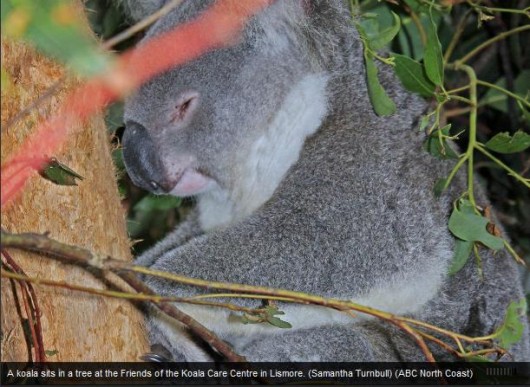
Ms Vass said statistics as well as anecdotal evidence showed koala numbers were rapidly declining, particularly in the Tweed (north eastern coastal New South Wales).
“I live at Wyrallah on a small property where koalas come and go, on the basis of observation at home I know that we’re seeing nowhere near as many koalas as we used to”, she said.
“In terms of statistics we’re actually bringing into care more koalas than we used to, but at the same time there are particular areas where we’re not bringing in as many koalas as we used to. So there are areas of local stress and the coastal area of Tweed is certainly one of those.”>>
[Source: ‘Greater protection for koalas‘, by journalist Samantha Turnbull, 20120430, ABC North Coast New South Wales, Australian Broadcasting Corporation, ^http://www.abc.net.au/local/photos/2012/04/30/3491805.htm, accessed 20121102]
.
<<This poor Koala was attacked by a Rottweiler in a suburban yard. It was reported that the koala was trying to get away and the dog grabbed it by the hindquarters as it was shimmying up a tree.
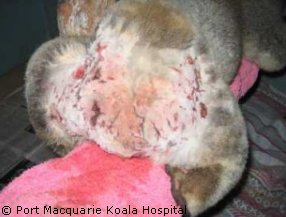 Koala injuries from a dog attack
Port Macquarie Koala Hospital
^http://www.koalahospital.org.au/ Koala injuries from a dog attack
Port Macquarie Koala Hospital
^http://www.koalahospital.org.au/
.
Sadly, this is a common occurrence with Koala’s. If it is not the hindquarters that are grabbed is around the neck or shoulder area. Usual injuries from this kind of incident are multiple puncture and tear wounds, with massive internal canine crush injuries. This koala had about 60 odd puncture wounds on his rump and groin area with many deep lacerations. His musculature around the groin and thigh area was lacerated pretty badly.
He died from shock, blood loss and ultimately a perforation of the intestine. The staff at the hospital gave him large amounts of fluids, and he was on strong painkillers and antibiotics. His wounds were flushed and he was kept in a warmed environment, but he died anyway.>>
[Source: Fourth Crossing Wildlife, ^http://www.fourthcrossingwildlife.com/dog_attack.htm]
.
.
Koala road deaths increasing
.
<<Not-for-profit conservation group, Friends of the Koala say 52 koalas were killed by vehicles on north coast roads last year.
The findings are part of the organisation’s annual report which documents the reasons behind the deaths of 222 north coast koalas. Association president Lorraine Vass says dog attacks and disease account for many koalas in their care. But she says hits from cars are the biggest concern.
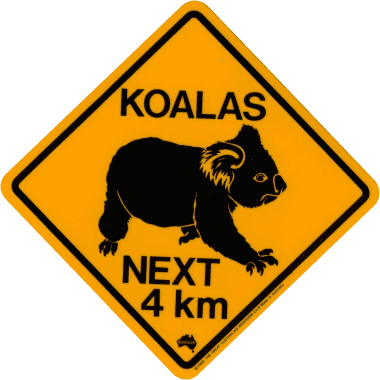
“One disturbing trend is an increase in road strikes,” she said. “Unfortunately that is a number that just keeps on increasing and last year we had 52 reports of koalas hit by cars. “Most of them, I’m afraid, were mortalities.”
But Ms Vass says there’s a positive outlook for koalas despite the figures. “I think there’s a lot to be optimistic about in terms of what’s going on with koala protection this year we’ve seen Lismore, we’ve got Tweed and Byron, those councils all working on a koala plan of management,” she said. “We’ve seen the federal announcement of the koala being listed under federal law as I say there’s a lot to be optimistic about.”>>
[Source: ‘Koala road deaths on rise‘, by Elloise Farrow-Smith, ABC, 20121019, ^http://www.abc.net.au/local/stories/2012/10/19/3614061.htm]
.
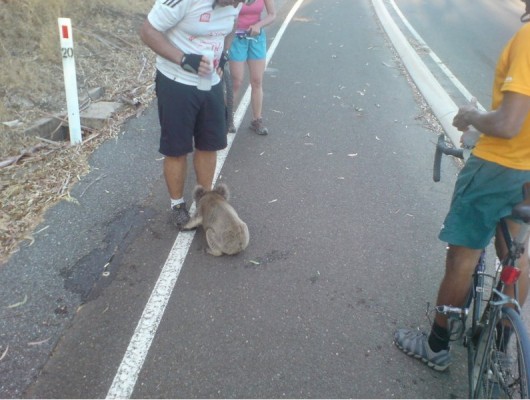 Koalas face a bleak future Koalas face a bleak future
.
Ed: The International Union for Conservation of Nature‘s global framework God-like governance for wildlife threatened by humanity is all about prioritising wildlife species most at risk of extinction for most protection.
.
It proclaims that if a species is not about to become extinct in the next ten years, its is not as important for conservation as those species that are.
.
But this is an Armageddon last man standing rationalisation. It may be administratively convenient, but it is an economic utilitarian philosophy that denies the rights of native wildlife to exist freely without persecution.
.
Were such an IUCN rationalist framwork applied to humans, such that don’t worry about say Chinese or Indians catching a deadly pandemic because there are a billion of them, it would be labelled as Herbert Spencer’s Social Darwinism or as Nazi Eugenics and quite rightly so. At The Habitat Advocate we espouse a worldview of Nature through: ^Deonteological Ethics and >Species Justice.
.
Every wildlife individual is valuable and has existence rights no different to humans.
.
Test: Would a human mother sacrifice her eldest or her youngest?
.
[Ed: All references sourced for this article 20111102]
.
.
Further Reading:
.
[1] ‘Koala Species Profile‘, Species Profile and Threats Database, Department of Environment etc, Australian Government, ^http://www.environment.gov.au/cgi-bin/sprat/public/publicspecies.pl?taxon_id=85104
.
[2] ‘Listing Advice to protect the Koala under the EPBC Act‘, Department of Environment etc, Australian Government,^http://www.environment.gov.au/biodiversity/threatened/species/pubs/197-listing-advice.pdf >Read Listing Advice (42 pages, PDF, 400kb – – NB. if slow to open, GoTo: File > Save As.., then open the PDF file from your auto-download folder)
.
[3] Koala Habitat Distribution Map (surveyed in 2011), Department of Environment etc, Australian Government, 2012 ^http://www.environment.gov.au/biodiversity/threatened/species/pubs/phascolarctos-cinereus-distribution-map.pdf
>Read Map (PDF, 300kb – NB. if slow to open, GoTo: File > Save As.., then open the PDF file from your auto-download folder)
.
[4] ‘Koala now threatened species‘, 20120215, Radio National Breakfast (radio programme), Australian Broadcasting Corporation,’There’s quiet optimism among koala experts that our national icon will finally be classified as a threatened or endangered species’.^http://www.abc.net.au/radionational/programs/breakfast/2012-02-15/3830832
>Play .mp3 audio:
 ℗ 2012 Australian Broadcasting Corporation ℗ 2012 Australian Broadcasting Corporation
.
[5] ‘Iconic animals – the koala‘, by Margot Foster, 20111228, ABC Rural (radio programme), Australian Broadcasting Corporation,
Abstract: ‘Michael Cathcart looks at the current efforts to protect this vulnerable animal. A senate committee has been looking into ‘the status, health and sustainability of Australia’s koala population’. He discovers the koala’s role as a cultural icon and the impact on our awareness of the koala, made by Norman Lindsay, as well as Dreamtime representations of the koala which reveal a great deal about the unique physiology and habits of this elusive animal.
The history of extensive slaughter of the koala since white settlement, because of the quality of its fur and value abroad, is an irony today because on Raymond Island, East Gippsland, koalas are making too many babies. There are about three hundred koalas on the small island and Department of Sustainability and Environment wildlife manager Charlie Franken says that’s about 250 too many.
Michael Cathcart speaks with Deborah Tabart OAM, CEO of the Australian Koala Foundation; Ann Moyal, author Of “Koala: A Historical Biography”; Michael J Connolly, Munda-gutta Kulliwari, Dreamtime Kullilla-Art; Helen Glad, Norman Lindsay’s grand daughter; Ann Moyal, author and historian; Charlie Franken, wildlife manager, Department of Sustainability and Environment; Dr Jay Patterson, Melbourne zoo vet and Dr Grant Kuseff, Bairnsdale veterinary surgeon;
^http://www.abc.net.au/rural/telegraph/content/2011/s3390776.htm
>Play .mp3 audio (large data file so may take a minute):
 ℗ 2011 Australian Broadcasting Corporation ℗ 2011 Australian Broadcasting Corporation
.
[6] ‘Interim koala referral advice for proponents‘, June 2012, Department of Environment (etc.), Australian Government,
Abstract: ‘Koala (Phascolarctos cinereus) populations in Queensland (QLD), New South Wales (NSW) and the Australian Capital Territory (ACT) have been listed as vulnerable under the Environment Protection and Biodiversity Conservation Act 1999 (EPBC Act). This listing came into legal effect on 2 May 2012. The listed threatened QLD, NSW and ACT populations are hereafter referred to in these guidelines as the koala.’
^http://www.environment.gov.au/epbc/publications/pubs/bio240-0612-interim-koala-referral-advice.pdf
.
[7] Australian Koala Foundation, ^ https://www.savethekoala.com/
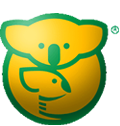 . .
[8] Koala Hospital, Port Macquarieuth Wales, ^ http://www.koalahospital.org.au/
 . .
[9] IUCN. (2001). IUCN Red List Categories and Criteria: Version 3.1. IUCN Species Survival Commission. IUCN, Gland, Switzerland and Cambridge, UK. ii + 30 pp, ^ http://www.iucnredlist.org/documents/redlist_cats_crit_en.pdf , >Read Document
.
Tags: Australian Koala Foundation, Black August, endangered koalas, Environment Protection and Biodiversity Conservation Act, Estimated Australian Koala Population, Friends of the Koala, Greater protection for koalas, iucn, Koala, Koala Crunch Time, koala extinction, koala habitat, Koala Protection Act, Koala Protection Bill, Koala road deaths, Koala road deaths on rise, National Koala Conservation and Management Strategy, New South Wales, Phascolarctos cinereus, Queensland, Save the Koala, Senate Committee Recommendations, South Australian koalas, The International Union for Conservation of Nature, The koala—saving our national icon, Threatened Species Scientific Committee, Victorian koalas, Westfield
Posted in Koalas, Threats from Development | 2 Comments »
Add this post to Del.icio.us - Digg
Friday, June 22nd, 2012
 Green Sea Turtle (Chelonia mydas)
Also known as Green Turtle, Black (sea) Turtle, or Pacific Green Turtle and can be found on Australia’s Great Barrier Reef.
The species is listed as ‘Endangered‘ by the IUCN and CITES and is protected from exploitation in most countries where it is illegal to collect, harm or kill them. Green Sea Turtle (Chelonia mydas)
Also known as Green Turtle, Black (sea) Turtle, or Pacific Green Turtle and can be found on Australia’s Great Barrier Reef.
The species is listed as ‘Endangered‘ by the IUCN and CITES and is protected from exploitation in most countries where it is illegal to collect, harm or kill them.
.
Australia’s Great Barrier Reef is one of the world’s seven natural wonders. It is the world’s largest reef system stretching over 2,600 kilometres from Lady Elliot Island off Gladstone Harbour up to the top of Cape York Peninsula at the Torres Strait.
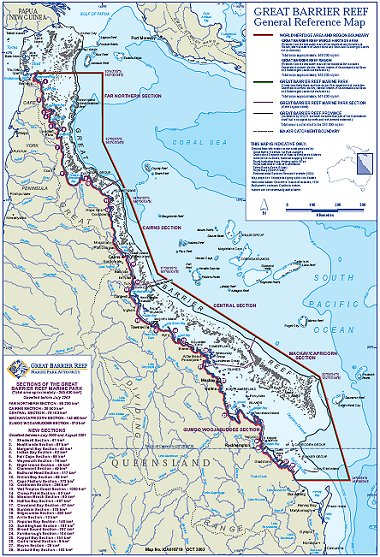
The Great Barrier Reef has 411 types of hard coral, comprises 900 islands and 2,900 individual coral reefs as well as many cays and lagoons . It is a natural sanctuary for 36 species of marine mammals including whales, dolphins and porpoises, some 1500 fish species, 134 species of sharks and rays, 4,000 types of mollusc and is home to 215 species of birds either migrating, nesting or roosting on the islands.
The Reef and associated beaches provide vital habitat home to six species of sea turtles which swim vast distances to the reef to breed including the Green Sea Turtle. Both the Green Sea Turtle and the unusual Dugong are species particularly threatened with extinction due to Aboriginal Poaching and associated non-traditional commercial exploitation.
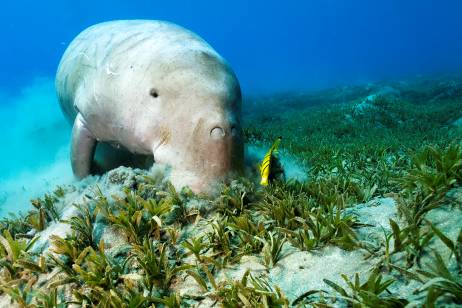 Dugong (Dugong dugon) feeding on Sea Grass Meadows
(Photo by Barry Ingham) Dugong (Dugong dugon) feeding on Sea Grass Meadows
(Photo by Barry Ingham)
.
Dugongs?
.
Dugongs were hunted toward extinction by European colonists during the 19th Century for their meat and oil.
Most Dugongs now live in the northern waters of Australia between Shark Bay and Moreton Bay particularly in the Torres Strait and along the Grest Barrier Reef. Ongoing ‘traditional’ hunting is driving populations close to extinction. Consequently the IUCN lists Dugongs as ‘Vulnerable‘ to extinction, while the CITES limits or bans the trade of derived products.
Australian Aborigines and Torres Strait Islanders ignore this and continue to poach Dugongs for non-traditional commercial exploitation. ^Read about Dugongs
.

In 1981, The Great Barrier Reef was inscribed on the UNESCO’s World Heritage List under all four natural World Heritage criteria for its outstanding universal value:
- Outstanding example representing a major stage of the Earth’s evolutionary history
- Outstanding example representing significant ongoing geological processes, biological evolution and man’s interaction with his natural environment
- Contains unique, rare and superlative natural phenomena, formations and features and areas of exceptional natural beauty
- Provide habitats where populations of rare and endangered species of plants and animals still survive
.
The IUCN-protected Great Barrier Reef Marine Park is 345,000 square kilometres in size; five times the size of Tasmania or larger that the United Kingdom and Ireland combined!
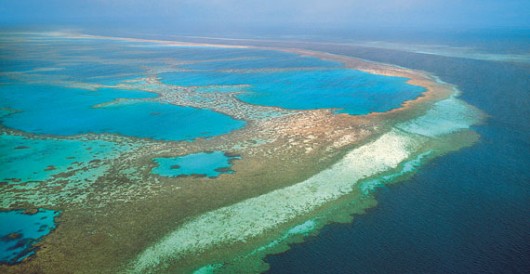
As scientists have become to understand more about the Reef’s complex ecosystem, they have discovered that damaging fishing practices, pollution and coral bleaching exacerbated by increased sea temperatures due to global warming are compounding to jeopardise the Reef’s future.
 . .
The ecological protection and management of the Great Barrier Reef Marine Park is delegated by the IUCN to the safe custody and sovereignty of the Australian Government, currently under the Minister for Sustainability, Environment, Water, Population and Communities, Tony Burke MP. The management task in turn has delegated the responsibility to The Great Barrier Reef Marine Park Authority guided by the Great Barrier Reef Marine Park Act 1975 (Cwlth), which is headquartered in Townsville and with regional offices in Cairns, Mackay, Rockhampton and Canberra.
.
“The Great Barrier Reef is internationally recognised for its outstanding biodiversity. The World Heritage status of the Reef recognises its great diversity of species and habitats. Conserving the Reef’s biodiversity is not just desirable – it is essential. By protecting biodiversity, we are protecting our future and our children’s future.”
~ GBRMPA website
.
Great Barrier Reef Tourism
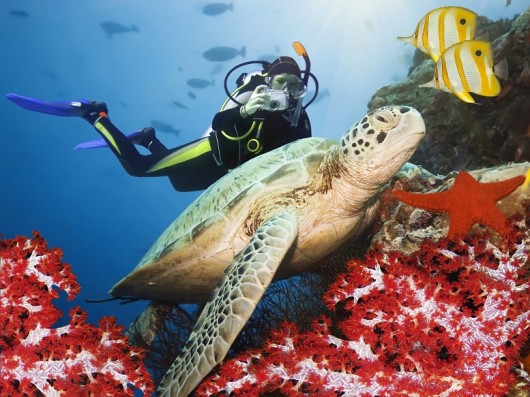 Because of the Reef’s magnificent biodiversity, diving on the Reef is very popular
(Diver with Green Sea Turtle) Because of the Reef’s magnificent biodiversity, diving on the Reef is very popular
(Diver with Green Sea Turtle)
Tourism Australia promotes the Reef thus:
.
‘Once you’ve experienced the Great Barrier Reef you will know why it is one of the seven wonders of the natural world. Diving and snorkelling are a must. Stay at a one of the many heavenly island resorts. Charter a yacht and sail The Whitsundays. Find your own uninhabited island. Where else in the world can you find a beach where the only footprints in the sand are your own.
There are hundreds of dreamy islands and coral atolls on the World Heritage-listed Great Barrier Reef, so take your pick. Luxury lovers and honeymooners will be in heaven on Lizard Island, exclusive Bedarra or privately-owned Double and Haggerstone Islands. For a wilderness experience, bush camp on Fitzroy Island or trek the Thorsborne Trail along mist-cloaked Hinchinbrook Island. Day trip to Green and Fitzroy Islands, snorkel the brilliant coral reefs of the Low Isles or sea kayak around Snapper Island, Hope Islands National Park with an Aboriginal guide. Townsville, Port Douglas and Lucinda are just some of the mainland gateways.’
.
And at the northern tip of the Reef, Cape York and the Torres Strait Islands are promoted thus:
.
‘Sitting just north of Cape York, between Australia and Papua New Guinea, the Torres Strait Islands are made up of 274 small islands, only 17 of which are inhabited. These communities have developed a unique blend of Melanesian and Australian Aboriginal cultures. Get a glimpse with a trip to Thursday or Horn Island, the group’s most developed islands. Learn about the local pearling and fishing industry on Thursday island, reached by ferry from Cape York. Visit the museum, art gallery and historic World War II sites on Horn Island, accessible by flight. Both islands are blessed with pristine beaches, azure waters and vivid fringing reefs supporting dugongs and sea turtles.’
.
[Source: Tourism Australia, a department of the Australian Government, ^http://www.australia.com/about/australias-landscapes/australias-islands.aspx]
.
It all seems like idyllic paradise!
.
..
Australia’s disturbing reality on The Reef and at Cape York
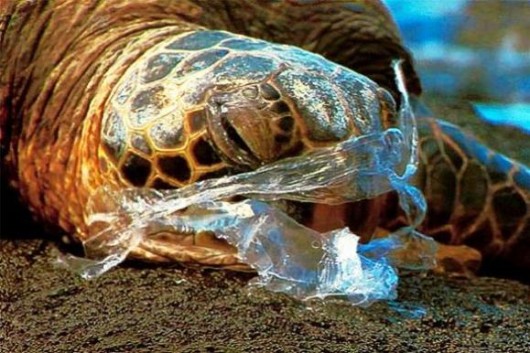
There are thousands of native Sea Turtles dying on our Great Barrier Reef as a result of:
- Water Pollution from sewage and stormwater
- Water pollution and farm pestidices, herbicides and fertilisers
- Damaging Fishing Practices
- Illegal Poaching
- Cyclones and Flooding
- Tredging of Gladstone Harbour and associated coastal Industrial Development
- Bulk Cargo Ships leaking contaminants
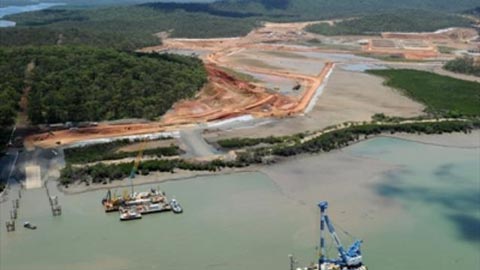
Gladstone Harbour dredging in 2011-12 by the Gladstone Ports Corporation and LNG
..continues to muddy Barrier Reef habitat and destroy Sea Grass Meadows critical to Sea Turtkes and Dungongs
.
The recent Queensland floods and cyclones have starkly shown the impacts of water pollution on the marine environment. Pesticide and mud pollution from out-dated farming practices has led to a massive spike in Dugong and Sea Turtle deaths.
In addition, poor fishing practices can still kill too many of our Sea Turtles and Dugongs, and industrial development is proliferating along the coast and removing remaining habitats, such as Sea Grass Meadows that Sea Turtles and Dugongs depend on for their survival.
Over the past 12 months, more than 1,400 turtles and 180 dugongs have washed up on our beaches. Clearly our Reef is under enormous pressure and our wildlife is suffering.
The Great Barrier Reef is a World Heritage global icon and something that Queenslanders are proud to be the custodians of. It is unacceptable to many of us that the Reef would be under this amount of pressure. We’re not alone in these concerns – UNESCO’s World Heritage Committee also expressed serious concern recently about the long-term health of the Great Barrier Reef.
[Source: ^http://support.wwf.org.au/queensland-turtles.html]
.
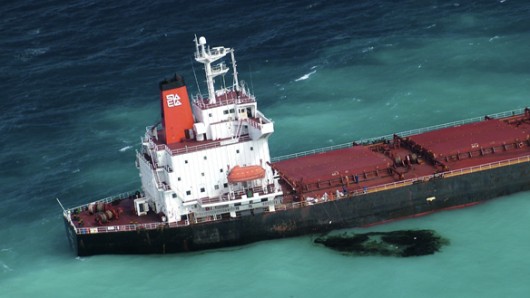 Oil is seen next to the 230-metre bulk coal carrier Shen Neng I about 70 kilometres east of Great Keppel Island, 20100404.
“damage to the reef is significant, with large parts of Douglas Shoal “completely flattened” and marine life “pulverised”.
(Maritime Safety Queensland/Reuters) Oil is seen next to the 230-metre bulk coal carrier Shen Neng I about 70 kilometres east of Great Keppel Island, 20100404.
“damage to the reef is significant, with large parts of Douglas Shoal “completely flattened” and marine life “pulverised”.
(Maritime Safety Queensland/Reuters)
.
‘130 turtles stranded this year‘
.
‘The Scientific Advisory Committee has been charged with the task of investigating this year’s spate of marine animal deaths in Gladstone Harbour.
Responding to calls for all results to be made public, the environment minister’s office provided the following data:
- 130 turtle strandings were reported; 11 of those were released or in rehabilitation
- Of 119 turtles found dead in the harbour this year, only 24 had autopsies conducted
.
Of those 24 turtles, 13 were identified as dying from human activity (11 boat strikes and two undetermined); 11 were identified as dying from natural causes (10 from ill health and disease and one undetermined).
Eight Dugongs have been found dead. One was killed by boat strike and one from netting. The remaining six were too badly decomposed for autopsies.
Five Dolphin deaths were reported. One was caused by unspecified human activity. The remaining four were too decomposed.
Because floods damaged seagrass levels, marine animals are more vulnerable to human activity.’
[Source: ‘130 turtles stranded this year’, 20110824, ^http://www.gladstoneobserver.com.au/story/2011/08/24/130-turtles-stranded-in-harbour-this-year/]
.
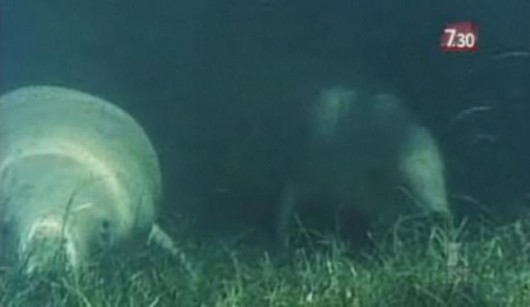 . .
‘Another Dugong death’
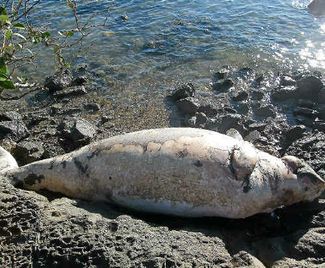 This dead dugong was found on Witt Island by Clive Last (July 2011)
who is increasing worried by marine animal deaths in Gladstone Harbour (Great Barrier Reef). This dead dugong was found on Witt Island by Clive Last (July 2011)
who is increasing worried by marine animal deaths in Gladstone Harbour (Great Barrier Reef).
.
‘Another dead Dugong has been found in Gladstone Harbour, and the man who found it wants some answers.
Clive Last, who in May discovered a dead dolphin on Turtle Island, was shocked on Friday afternoon when he found the body of a dead Dugong on Witt Island.
Mr Last is wary of suggestions marine animal deaths this year can be attributed to boat strikes and net fishing. He said those explanations didn’t match his observations on the harbour.
“I honestly believe it’s either starvation (from damaged seagrass meadows) or there is something in the harbour,” Mr Last said. “Right now, Turtles and Dugongs are continually coming up. That means there is (something) going on.”
He believed the Dolphin he found in May had no injuries to indicate it had been killed by boat strike or fishing nets.
The Department of Environment and Resource Management reported the Dolphin’s body was too decomposed to conduct a necropsy.
Mr Last said, once again, the dead Dugong’s body showed no sign of injury. He took five photos and called Queensland Parks and Wildlife.
Mr Last, whose work requires him to spend a lot of time on the harbour, is increasingly disturbed by the trend of dead marine animals in Gladstone Harbour.
“If I don’t see another one after today, I’ll be very happy,” he said. “I’d also be very happy if someone would come up with the truth about what is really killing them. “You can’t keep saying it’s boat strike, when I’ve got photos showing it’s not boat strike.”
Mr Last said he was worried the scientific advisory committee’s investigation into the deaths in Gladstone Harbour would take too long to come up with results.
DERM (Queensland Department of Environment and Resource Management) could not be contacted over the weekend.
The list goes on:
- The dead Dugong found on Witt Island was the latest in a long, mysterious list of marine animal deaths this year.
- Three dead Dolphins were found in Gladstone Harbour in May, within two weeks of each other.
- The latest discovery is the fourth Dugong found dead in the harbour since May
- More than 40 Turtles have washed up dead in the harbour since April. The Turtle deaths have been the subject of intense debate between environmentalists and commercial fishermen.
- Marine experts from various organisations have told The Observer seagrass levels, damaged by the floods, are putting stress on the animals.
.
“LNG will deliver billions of Australian Dollars to be shipped overseas as profit we will be left with the rotting carcasses of dead dugongs, poisoned water tables, destroyed farmland and a bill for the infrastructure the council builds for them.”
~ Comment by Chris Norman from Agnes Waters (July 2011)
.
[Source: ‘Another dugong death’ by David Sparkes, The Gladstone Observer, 20110725, ^http://www.gladstoneobserver.com.au/story/2011/07/25/another-dugong-death-marine-deaths-gladstone/]
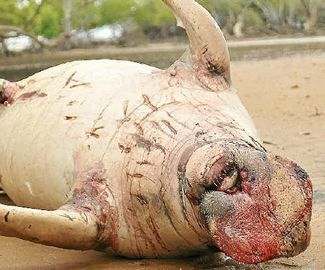 Dugong washed up at Gladstone – marked with gashes Dugong washed up at Gladstone – marked with gashes
.
Heinous cruelty as Aborigines hack live pregnant Green Sea Turtle
.
There’s tension in far north Queensland between Traditional Hunting rights (Ed: read ‘perversion’) and the protection of Turtles and Dugongs, and it is resulting in some horrific treatment of native animals.
Transcript from ABC Broadcast (extracts of video added):
.
CHRIS UHLMANN, PRESENTER: Protected Dugongs and Sea Turtles are being cruelly slaughtered in Queensland’s Torres Strait to supply an illegal meat trade.
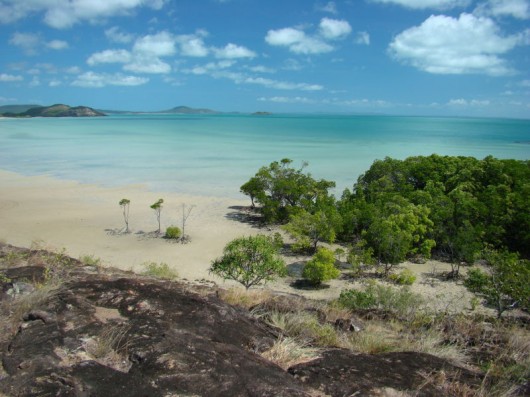 Tranquil coastal tip of Cape York Peninsula and the Torres Strait Tranquil coastal tip of Cape York Peninsula and the Torres Strait
.
An investigation by 7.30 has found deeply confronting footage that we are about to air. It shows the brutal methods used to hunt the animals, with turtles being butchered alive and dugongs drowned as they’re dragged behind boats.
The investigation throws into sharp relief the conflict between Indigenous Australians and animal rights activists over traditional hunting and exposes a black market in animal meat.
And a warning: this report by Sarah Dingle and producer Lesley Robinson contains disturbing images and coarse language.
SARAH DINGLE, REPORTER: At the northern-most tip of Australia lie the serene islands and waters of Queensland’s Torres Strait, the birthplace of Native Title. But on those beaches, there’s a slaughter underway.
7.30 travelled to far North Queensland where IT entrepreneur turned eco warrior Rupert Imhoff has been investigating the fate of threatened turtle and dugong populations. And what he found is shocking. A turtle lies tethered for up to three days, waiting to die.
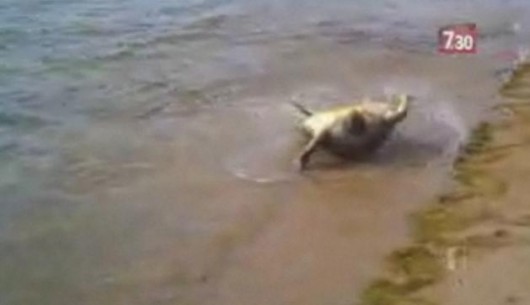 Green Sea Turtles are routinely tethered by rope by local Aboriginal/Torres Strait Islander men in the shallows,
then inverted on to their backs so that they tire from struggling and often drown. Green Sea Turtles are routinely tethered by rope by local Aboriginal/Torres Strait Islander men in the shallows,
then inverted on to their backs so that they tire from struggling and often drown.
.
RUPERT IMHOFF, ECO WARRIOR: They dragged it out of the water, flipped it on its back. You could see it was already terrorised. It was flapping around madly. And they came up with this concrete block and basically tried to slam it in the head, obviously to stun the animal. Didn’t quite work.
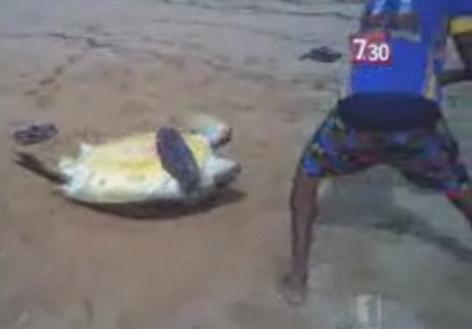 Man uses a concrete block and throws it twice at the Turtles head
but the female Turtle continues to flap. She has no voice. Man uses a concrete block and throws it twice at the Turtles head
but the female Turtle continues to flap. She has no voice.
.
SARAH DINGLE: The images become even more confronting.
RUPERT IMHOFF: Before they started hacking off its fins, they wanted to check if it was pregnant, and sure enough this turtle was a mature aged turtle. Had up to 125 eggs in it. It was gonna be the next generation of turtles, but they decided to cut it up right there and then.
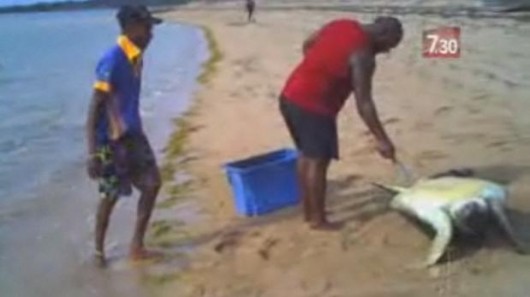 Aboriginal man knifes into the womb of the female Turtle to see it if pregnant
– she is. Aboriginal man knifes into the womb of the female Turtle to see it if pregnant
– she is.
.
SARAH DINGLE: Even as it’s hacked, the turtle clings to life, apparently in agony for seven and a half minutes.
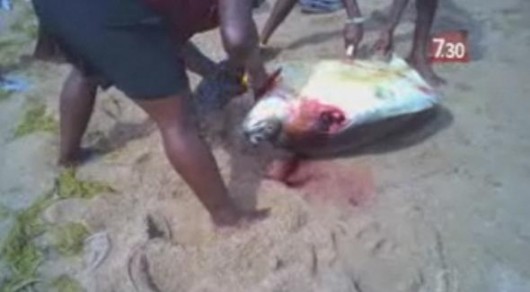 The man then starts hacking into the live healthy Turtle
Left flipper already hacked off, the still live turtle has its right flipper hacked off,
while the men keep it helplessly lying on its back The man then starts hacking into the live healthy Turtle
Left flipper already hacked off, the still live turtle has its right flipper hacked off,
while the men keep it helplessly lying on its back
.
RUPERT IMHOFF: Didn’t actually die until they took off the bottom shell, they actually peeled off the shell and then it just let out one gasp – one last gasp of air and passed away.
SARAH DINGLE: Using a hidden camera, Rupert Imhoff spent two weeks in the Torres Strait filming the hunting of sea turtle and dugong which are both listed as vulnerable to extinction.
RUPERT IMHOFF: They go out, they spear them at sea, they then tie the tail to the back of the boat and they hold the head underwater. And it can take up to seven and a half minutes again, so I’ve been told, for that dugong to drown.
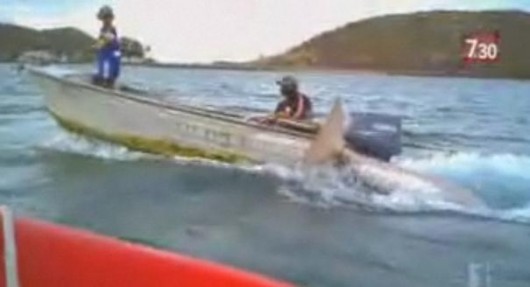 Speared Dugong, still alive is tied by the tail fin to the side of the boat so it drowns as the boat returns to shore Speared Dugong, still alive is tied by the tail fin to the side of the boat so it drowns as the boat returns to shore
.
SARAH DINGLE: Here, a Dugong is methodically carved up for consumption. For anyone else, this kill would be illegal, as dugong are protected under federal law. However, the Native Title Act allows traditional owners to hunt to satisfy their personal, domestic or non-commercial communal needs.
Anywhere in Australia, this horrific cruelty would be will illegal. But in Queensland alone, Native Title hunting is exempt from animal cruelty laws. Animal rights activists are appalled.
Lawyer Rebecca Smith was a paid consultant on the turtle and dugong hunt for the Torres Strait Regional Authority.
REBECCA SMITH, LAWYER: Most conservation groups won’t touch this issue. It’s just too hard, too prickly, too sensitive. It’s often deemed – people who are opposed to traditional hunting are often called racist, but there’s nothing racist about saying, “This is cruel. We’ll move on from there. We’ll do this humanely now. We’ve progressed.”
SARAH DINGLE: Aerial surveys of dugong and turtle numbers are imperfect and no-one knows exactly how many there are. Green sea turtles face an extra pressure. They’re by far the turtle species most intensively hunted for their meat. But locals say there are bigger threats for turtle and dugong.
???: You know we are under threat from pig predation, our – one of the greatest, biggest rookeries in the Southern Hemisphere on Cape York, Rain Island, is under threat from climate change, but we seem to be concentrating I think far too much on, you know, Indigenous people hunting them.
SARAH DINGLE: What is known is that the Great Barrier Reef is a last stronghold. It’s home to the biggest sea turtle rookery in the globe and one of the world’s largest population of dugong.
Cairns-based Colin Riddell calls himself “The Dugong Man”. A former abattoir worker, he’s an unlikely but tireless campaigner for animal rights.
COLIN RIDDELL, ANIMAL RIGHTS CAMPAIGNER: I have to pursue it to the end because otherwise the end may be for the animals.
SARAH DINGLE: Colin Riddell’s investigations have revealed the slaughter goes on far to the south in coastal Queensland waters.
Green Island is one of the jewels in the crown of Cairns tourism. We’ve been told just last week at this spot Indigenous hunters chased down and took a green sea turtle in full view of shocked tourists. There’s no way of knowing where those hunters came from, but locals say this is a weekly occurrence on this island.
STEVE DAVIES, TOUR OPERATOR: They can be out there a lot, you know – three, four, five times a week. They come across in quite large tinnies with large outboard motors on board and they chase the turtles till they’re completely and utterly exhausted.
SARAH DINGLE: The culture clash between hunters and tourists has led to heated confrontations.
INDIGENOUS HUNTER (Amateur video): This our land! We don’t list end to your shit, mate! We can do anything on this land we wanna do, mate!
SARAH DINGLE: This video was shot two weeks ago by a tourist and given to 7.30. It shows an allocation between a tour boat and three Indigenous hunters.
INDIGENOUS HUNTER (Amateur video): Ya just don’t tell us what to do on our land! You’re not from this f***in’ land; we are! We’re the traditional owner! We own every f***in’ reef around here, mate!
SARAH DINGLE: It’s not clear what they’re hunting for, but there’s no mistaking the tensions.
INDIGENOUS HUNTER (Amateur video): You f*** off back to your country. This is my country, c***.
SARAH DINGLE: Is there a sense in your area that the Indigenous hunters are untouchable?
STEVE DAVIES: Without a doubt. And they believe they’re untouchable.
SARAH DINGLE: But there are conservation efforts.
Well away from the glitzy marinas and the tourist strip, here in the industrial area of Cairns is the town’s only turtle rehabilitation centre. It’s run on the smell of an oily rag. Here, injured and starving turtles are treated and brought back to full health.
Today, Jenny Gilbert and her team are readying a 180 kilogram breeding age female green sea turtle for release. By the look of things, this 80-year-old turtle has already survived a number of hazards.
Turtles like this are being hunted not traditionally, but for a very modern purpose. Our investigations have revealed the hunt is feeding a flourishing black market.
JAMES EPONG, MANDUBARRA LAND & SEA CORP.: Well nine times out 10 the illegal trade is to sell the meat for the benefit – for grog money or drugs.
SARAH DINGLE: And can you can make a buck out of it?
JAMES EPONG: Yes. There’s one person that we know of in Yarrabah made $80,000 one year.
SARAH DINGLE: James Epong is a Mandubarra man who lives on his traditional lands an hour south of Cairns and Yarrabah. The Mandubarra have declared a moratorium on taking turtle and dugong from their see country, but around them, the illegal meat trade continues.
JAMES EPONG: I myself went to a pub on a Friday afternoon to go and have a coldie with one of me mates and was approached by some other Indigenous people with trivac (phonetic spelling) meat for sale, which was turtle and dugong.
SARAH DINGLE: On four separate occasions 7.30 has confirmed multiple eskies arriving on the afternoon flight from Horn Island to Cairns.
RUPERT IMHOFF: I do not know 100 per cent for a fact what was in those eskies, but I have heard numerous reports and been told by the islanders themselves that they are transporting an excessive amount of turtle and dugong down to Cairns. Now on my flight I think there was about six or seven eskies that come off and I’ve been told that it almost a daily routine.
SARAH DINGLE: Indigenous sea rangers are employed and equipped by governments to care for marine wildlife. This esky was addressed to a ranger.
RUPERT IMHOFF: From what I understand and what I observed and what I spoke to the islanders about is the head hunters on all these islands are actually the rangers themselves. Now this money has gone into their pockets. It’s gonna help them buy outboard motors and help them basically go and hunt these turtle and dugong down in bigger numbers.
SARAH DINGLE: Were any of the people you saw hunting and killing animals rangers?
RUPERT IMHOFF: Yes, they were 100 per cent.
SARAH DINGLE: Did you pay those people in your footage to do what they were doing?
RUPERT IMHOFF: We did not pay a single person any money while we were up there.
SARAH DINGLE: And the illegal trade continues further south.
SEITH FOURMILE, CAIRNS TRADITIONAL OWNER: I know that there’s a lot of non-Indigenous people that are doing it as well.
SARAH DINGLE: Are they doing the hunting or are they involved in other way?
SEITH FOURMILE: They’re involved with the trading of it, or selling it and passing it down, and some of the turtle meats has gone far down as Sydney and Melbourne.
SARAH DINGLE: And it’s not just dugong and turtle meat being sold. Traditional owners from Cape York are pushing to end the indiscriminate slaughter and stop the esky trade.
 Sea Turtle air freighted from Cairns to Sydney and Melbourne
Nothing to do with ‘Traditional Hunting’, which is a low-life smokescreen for what it really is:
Illegal Wildlife Poaching and Trade for personal commercial profit. Sea Turtle air freighted from Cairns to Sydney and Melbourne
Nothing to do with ‘Traditional Hunting’, which is a low-life smokescreen for what it really is:
Illegal Wildlife Poaching and Trade for personal commercial profit.
.
FRANKIE DEEMAL, TURTLE AND DUGONG TASKFORCE: We don’t have that kind of legislative assistance to do that. What do you do when you confront a rogue killer?
SARAH DINGLE: And we’ve heard a lotta people talk about rogue killers. Who are these rogue killers?
FRANKIE DEEMAL: They’re there.
SARAH DINGLE: Who are they?
FRANKIE DEEMAL: They know who they are.
SARAH DINGLE: For those with Native Title rights, customs can change.
LOCAL MAN: We’re gonna name this turtle Bumbida (phonetic spelling), after our grandmother.
SARAH DINGLE: But the Mandubarra people at least have sworn to protect these animals.
CHRIS UHLMANN: Sarah Dingle with that report, produced by Lesley Robinson.
And 7.30 contacted the Queensland Department of Environment and Resource Management. In a statement it said it takes, “the claims very seriously and will investigate all reports of illegal hunting and poaching”.
You can follow the progress of the turtles released in this story by going to the sea turtle satellite tracking page.
Editor’s note: (April 16) the ABC also approached the Torres Strait Regional Authority (TSRA) several times over the course of a week prior to broadcast but their spokesperson was unavailable for comment.
Watch the entire Documentary aired nationally across Australia in March 2012:
WARNING: THIS VIDEO CONTAINS DISTURBING ANIMAL CRUELTY WHICH MAY OFFEND. WE INCLUDE IT TO PORTRAY THE REALITY OF AUSTRALIA’S TREATMENT OF TURTLES AND DUGONGS IN THE NAME OF ‘TRADITIONAL HUNTING’

[Source: ‘Hunting rights hide horror for dugongs, turtles’, by reporters Sarah Dingle and Lesley Robinson, documentary presented by Chris Uhlmann, 730 Programme, 20120308, Australian Broadcasting Corporation, ^http://www.abc.net.au/7.30/content/2012/s3448943.htm]
.
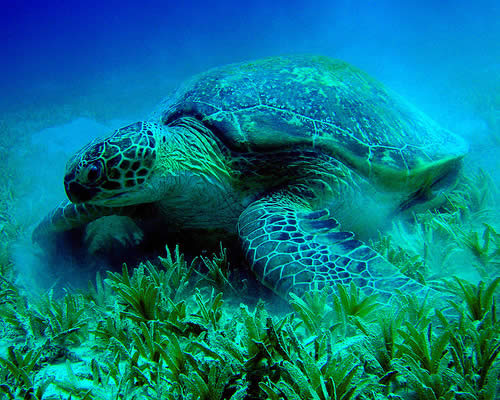
.
‘Queensland to outlaw Dugong-hunt cruelty’
.
Animal activists have welcomed moves by the Queensland Government to outlaw hunting-related cruelty to dugongs and turtles.
.
‘Under the Native Title Act, traditional owners are allowed to hunt Turtles and Dugongs.’
.
Footage aired on the ABC in March showed animals being butchered alive by some Indigenous hunters and sparked an investigation into the practice.
Queensland Fisheries Minister John McVeigh yesterday introduced legislation into Parliament to outlaw any unreasonable pain being inflicted during hunting.
The RSPCA’s Michael Beatty says the Government should be commended.
“No-one thinks – including the Indigenous leaders – that this type of cruelty, if you like, is necessary,” he said.
Mr Beatty says authorities need to continue to work with traditional owners. “It isn’t simply a case of just outlawing it, it really isn’t that simple because obviously it has to be policed as well,” he said.
But animal activist Colin Riddell says the hunting should be banned altogether. “People flock to Australia to see our Great Barrier Reef and see those beautiful animals and I fear for the day that my children, your children don’t get to see those animals,” he said.
Native title hunting rights would not be extinguished by the Bill.’
[Source: ‘Queensland to outlaw dugong-hunt cruelty’, 20120620, ABC, ^http://www.abc.net.au/news/2012-06-20/animal-rights-groups-welcome-cruelty-hunting-ban/4080688]
.
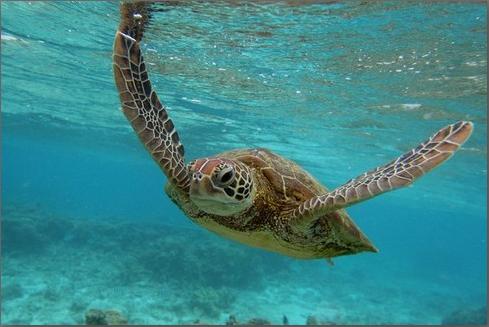
But this heinous cruelty by Indigenous Australians has long been know by the Australian Government..
.
Back in 2011: ‘Call for inquiry into marine animal poaching‘
.
The Federal Opposition has called for a judicial inquiry into Dugong and Turtle poaching in far north Queensland. Tourism operators say tourists have been exposed to mutilated and slaughtered turtles on island beaches, off Cairns. Four far north Queensland Liberal National Party (LNP) candidates say they want that stopped at key tourism sites.
Pictures of a mutilated turtle found on Green Island by tourists at the weekend have prompted public outrage. The animals are legally protected but the Native Title Act allows for hunting by traditional owners.
But Federal Opposition environment spokesman Greg Hunt says legal hunting is not the problem.
“The advice we have from Indigenous leaders is that the vast bulk of hunting is poaching,” he said. Mr Hunt says inaction on poaching is causing problems.
“There really has to be a crackdown on poaching,” he said. “The vast bulk of the take of Turtle and Dugong is coming from poaching. “There is a trade in illegally obtained meat and animal product. “This is a complete breach of the law.”
The Great Barrier Reef Marine Park Authority is investigating the issue.
[Source: ‘Call for inquiry into marine animal poaching‘, by Brad Ryan, ABC, 20111107, ^http://www.abc.net.au/news/2011-11-11/call-for-inquiry-into-marine-animal-poaching/3660324]
.
Back in 2010: ‘Cairns Turtle and Dugong activist campaigns against slaughter caught on video’
.
Former union activist turned environmental defender Colin Ridell, who counts Bob Irwin, John Mackenzie, Derryn Hinch and Greg Hunt MP among his loyal following, says the silence is deafening from the government to stop slaughter of turtles on the waters around Cairns.
Riddell is campaigning to reduce the taking of turtle and dugong, that is occurring under the protection of Native Title, until a complete scientific study is done to determine the actual numbers to be taken.
“It will be tightly controlled by the EPA and the elders with a permit system, that is monitored by special investigators. I and other indigenous elders support a moratorium to determine the take,” Riddell says. “The skulls of each to be kept to determine actual permitted numbers taken, as is done in other permit systems.”
He says that any breach would carry a substantial penalty, however advocates a complete ban in green zones, like all our coastal tourist areas. “I don’t want international tourists and interstate visitors to take home horror stories.”
The campaign follows the leaking of a graphic video showing a turtle having its flippers hacked off while still alive. RSPCA Queensland has called for a review of traditional hunting.
“It’s just not good enough, this is a violent and obscene way to treat these animals, ” Cairns resident Colin Riddell told CairnsBlog. “Any indigenous person is allowed to kill sea turtles and dugongs for weddings or funerals, but it has far beyond that, and is being commercially moved around the state.
“I don’t want international tourists and interstate visitors to take back horror stories home,” he says Riddell, who has taken his campaign to every State and Federal Government minister.
“I’ve written to the Minister for Local Government and Aboriginal and Torres Strait Islander Partnerships who have acknowledged my letter,” Riddell says. “The replied thanking me for me letter and said it ‘will be actioned as appropriate.’ However I have received no response,” he says.
Riddell has also wrote to Greg Combet for support, who he engaged with as a Manufacturing Workers Union site convener at the Australian Defence Industries Benalla plant. He says that Environment Minister Peter Garrett has also given him the “bum’s rush.”
“I received a response from the ‘Parliamentary Clearance Officer’ however it was totally unsatisfactory,” Riddell said. “I told them to get my message Peter Garrett, which was a direct result of Jim Turnour’s and Peter Garrett staffers. Weak efforts.”
Another response from the International Whaling Commission fell on deaf ears. “I asked them why we condemn Japan when Australians do the same,” Colin Riddell said. Julie Creek, responded. “Your message was deleted without being read.”
The original poster of the graphic video says that it’s fair enough if you have to kill turtles because it is a “traditional right” but who cuts the leg of a cow first and let it die in its own blood?
“No one is going to starve in Australia because we stop the killing of turtles. Australia earns millions of dollars with the tourism industry – with tourists who come to dive with turtles and in the same country we torture the turtles to death,” the anonymous poster wrote. “Species will vanish forever and in the end it does not matter whose fault it was. This is not a question of human races this is a question of respect and ethics towards other creatures.”
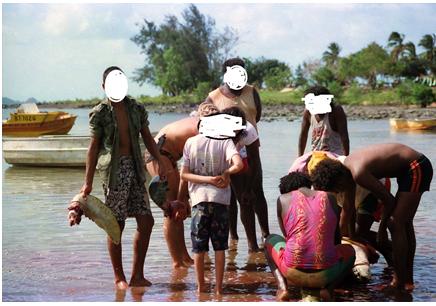
Colin Riddell and the RSPCA are trying to track down who shot the video and where it was taken, so they can investigate the incident. It is believed it was filmed in North Queensland mid last year.
.
“Until now cruelty to animals using traditional hunting methods has been put in the too hard basket by governments.”
.
Mark Townend of the RSPCA said. “Far from it, he said. We have Aboriginal and Torres Strait Island elders who support us on this issue.
.
“Hunting from tinnies with rifles is not traditional.”
.
“We’re committed to ensuring that any breaches of the Animal Care and Protection Act are fully investigated while at the same time taking into consideration traditional hunting rights,” RSPCA chief inspector Michael Pecic says. “We can’t do this alone. We’re a charity and yet it appears we’re the only organisation that is taking this matter seriously.”
“We have Aboriginal and Torres Strait Island elders who support us on this issue,” Riddell says. “Hunting from tinnies with rifles is not traditional. Leaving turtles and dugongs to be butchered alive and left to die on the beach is not traditional. We’re not attacking the indigenous community. This is simply not an appropriate way to kill these animals.”
James Epong, son of an aboriginal elder says that Ma:mu traditional owners have a right to hunt for protected species such as dugong and marine turtles that is recognised by Australian Law.
“Our Ma:mu traditional owners, who are also called the Mandubarra mob, have put aside some of these rights and signed a Traditional Use Marine Resource Agreement so they can protect rather that exploit dugong and marine turtles,” James Epong says.
The agreement for their turtle business is co-ordinated through the Mandubarra Land and Sea Corporation and was finalised in June 2008.
“I am very proud to see that Ma:mu traditional owners are prepared to sacrifice rights and traditions, for the sake of helping threatened turtle and dugong stocks recover,” Epong says. “Keep in mind the Ma:mu people are setting aside hunting and cultural practices that go back tens of thousands of years for the future benefit of all Australians.”
In 1996, a landmark High Court decision concerned with particular pastoral titles, was passed regarding Native Title hunting rights. The decision did not allow anyone simply to claim Indigenous links and then hunt and kill native animals anywhere in Queensland. It authorised any legitimate native title holder to hunt and kill for genuine sustenance and other needs and without first obtaining a licence, but only in areas over which native title is held by that group.
The decision did not allow native title owners to trap or kill wildlife for commercial purposes, however Colin Riddell says that this is occurring. “These area being transported through the Cairns Airport in Eskys,” he says.
Riddell says on his website that the 1996 decision says nothing one way or the other about using modern weapons like guns and powered boats to undertake traditional hunting. It is interesting that the use of harpoons, outboard-powered boats, and steel axes to kill the crocodiles as an exercise of native title hunting rights.
“It seemed to concern nobody on the High Court bench, with the possible exception of Justice Callinan. Followers of native title developments need to keep in mind the distinction between exercising an established native right in a modern way, as in the Yanner case, and the loss or abandonment of traditional and established native title rights themselves, as found by the trial judge to be a fatal flaw in the Yorta Yorta decision.”
.
Commercial Exploitation of Hunting and Fishing Rights
This issue, namely the extent to which the holders of native title may exercise the relevant rights in a “modern” fashion, and indeed the connected issue of whether they might even commercially exploit those rights, are difficult ones. Whilst not directly in issue in the Yanner case, these issues are of considerable importance in the broader scheme of Australian native title law – and are yet to be answered conclusively.
Some important developments in this area are taking place in Canada. In the Supreme Court of Canada’s 1997 decision in Delgamuukw v British Columbia, the majority judges noted that, while the rights of Indigenous title holders in that jurisdiction are not limited to engagement in activities which are aspects of practices, customs, and traditions integral to the claimant group’s distinctive Indigenous culture, lands held by Aboriginal title cannot be used in a manner that is irreconcilable with the nature of the claimants’ attachment to those lands.
So, for example, tribal hunting areas may not be “strip mined” or, so it would seem, “hunted out” or “fished out” in a large-scale commercial operation. Contrast this with small-scale trading between local Indigenous people and others, for which there is some historical and anthropological evidence in Australia and elsewhere.
There are important legal differences between the doctrines of Aboriginal title in Canada and Australia, but there are also some important similarities which indicate that these Canadian developments might in the future be of relevance in Australia. Of course, it is also important in Australia to note that the Commonwealth Native Title Act moderates but does not destroy the capacity of the States and Territories to regulate the exercise of native title rights along with other rights, as in fishing, conservation, and safety legislation which might apply equally to Indigenous and non-Indigenous people alike.
“Jim Turnour says this is a racial issue,” Colin Riddell says. “You know, I’m disgruntled as well. You know what I do. I tell you what, I’m begging people to vote for Warren Entsch in and get rid of Jimmy,” he says.
See the shocking video here…
WARNING: THIS VIDEO CONTAINS DISTURBING ANIMAL CRUELTY WHICH MAY OFFEND. WE INCLUDE IT TO PORTRAY THE REALITY OF AUSTRALIA’S TREATMENT OF TURTLES AND DUGONGS IN THE NAME OF ‘TRADITIONAL HUNTING’

[Source: ‘Cairns turtle and dugong activist campaigns against slaughter caught on video’, by Michael Moore’s Cairns.blog.net, 20100410, ^http://www.cairnsblog.net/2010/04/cairns-turtle-and-dugong-activist.html]
.
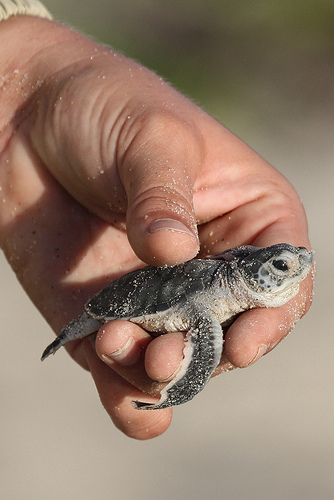 A species completely at our mercy A species completely at our mercy
.
Ed:
- The Great Barrier Reef Marine Park Authority has been aware, so is complicit, immoral, incompetent and so entire Board should now be immediately sacked, and any government employee (rangers or otherwise found to have been in anyway involved with the killing of Dungongs or Turtles or trading in their body parts.
- The killing of Dungongs or Turtles in Australia is to be immediately policed and investigated jointly by the Australian Government, whatever the causes of the deaths
- The Australian Government needs to amend Australia’s Native Title Act 1993 and Australian Crimes Act 1914 to make any cruelty toward any wildlife in Australia and its territories a criminal act under Australian Crimes Act. Traditional Hunting that involves cruelty is to be outlawed. It is Commercial Exploitation of Traditional Hunting and Fishing Rights.
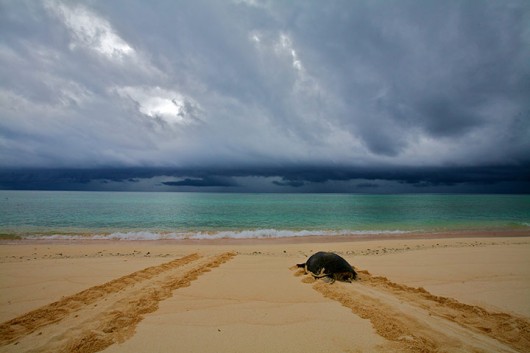 An horrific life, a bleak future An horrific life, a bleak future
It is 2012
.
References and Further Reading
.
[1] The Great Barrier Reef inscription on the UNESCO’s World Heritage List, ^ http://whc.unesco.org/en/list/154
.
[2] Australian Goverenment ^ http://www.environment.gov.au/heritage/places/world/great-barrier-reef/values.html
.
[3] Great Barrier Reef ^ http://www.greatbarrierreef.org/great-barrier-reef-facts.php
.
[4] The Great Barrier Reef Marine Park Authority ^ http://www.gbrmpa.gov.au/
.
[5] ‘ Three kilometres of Great Barrier Reef damage, 20 years to mend‘, by Tom Arup, The Age newspaper, 20100414, ^ http://www.theage.com.au/environment/three-kilometres-of-great-barrier-reef-damage-20-years-to-mend-20100413-s7p8.html
“It could take 20 years or more for the Great Barrier Reef to recover from three kilometres of destruction caused by the grounding of a Chinese coal ship, authorities have revealed. The Great Barrier Reef Marine Park Authority says the damage to the reef is significant, with large parts of Douglas Shoal “completely flattened” and marine life “pulverised”.
.
[6] ‘ WWF Welcomes investigation into marine wildlife deaths‘, World Wildlife Fund, 2011, ^ http://awsassets.wwf.org.au/downloads/pr252_wwf_welcomes_investigation_into_marine_wildlife_deaths_17jun11.pdf [> Read Media Release] – that was last year.
.
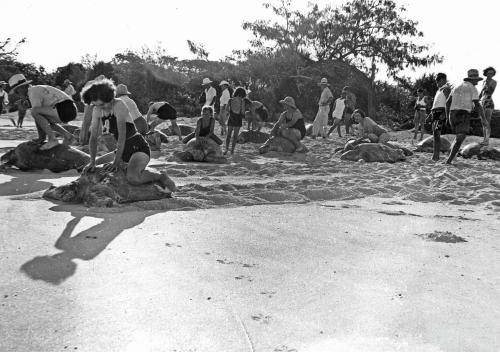 Australians Turtle Riding on Heron Island
Great Barrier Reef, 1938
[Source: © Queensland historical Atlas, ^http://www.qhatlas.com.au/category/keywords/great-barrier-reef] Australians Turtle Riding on Heron Island
Great Barrier Reef, 1938
[Source: © Queensland historical Atlas, ^http://www.qhatlas.com.au/category/keywords/great-barrier-reef]
.
Tags: Aboriginal Poaching, animal cruelty, animal welfare, Australia, Cape York, Cape York Peninsula, cites, Delgamuukw v British Columbia, Dugong, Gladstone Harbour, Great Barrier Reef, Great Barrier Reef Marine Park, Great Barrier Reef Marine Park Act 1975, Great Barrier Reef Tourism, Green Island, Green Sea Turtle, hacking holidays, Indigenous Culture, iucn, Lady Elliot Island, Queensland Holidays, Scientific Advisory Committee, Sea Grass Meadows, Shen Neng I, The Great Barrier Reef Marine Park Authority, Traditional Hunting Perversion, UNESCO's World Heritage Committee
Posted in Cape York (AU), Dugongs, Marine Wildlife, Threats from Fishing | 1 Comment »
Add this post to Del.icio.us - Digg
Saturday, August 28th, 2010
by Editor 20100828.
Sherwood Forest
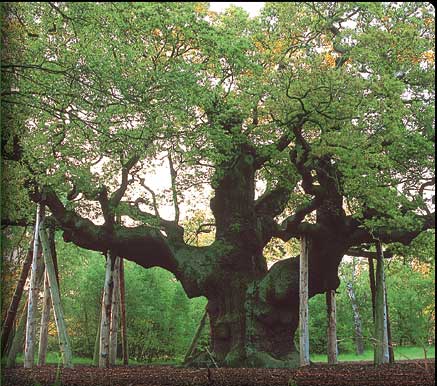 ‘Major Oak’ ‘Major Oak’
‘Yes, that Sherwood Forest. What was once a thick and dark mass of trees covering 100,000 acres (~20km x 20km) is now a spartan450 acres. Intense harvesting of the forest’s massive, ancient oaks for several centuries is the cause of the deforestation of this legendary woodland. Outcrops of Sherwood’s trees exist beyond the 450 acres but are not dense enough to be considered intact forest.’
[Source: WebEcoist.com ^ http://webecoist.com/2008/09/13/20-unusual-threatened-forests-around-the-world/]
Canada’s Red Mulberry – at risk of extinction
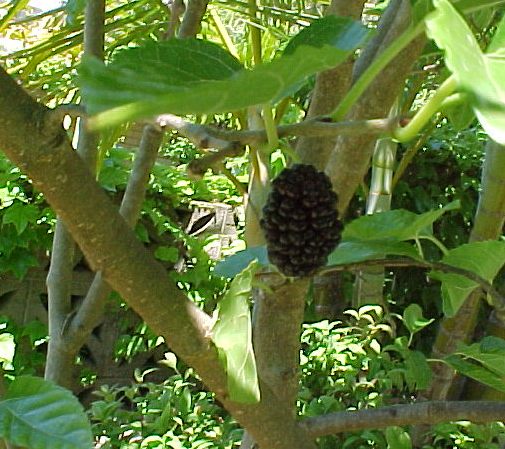 ‘The Red mulberry (Morus rubra) is one of Canada’s most endangered tree species and is only found in the Carolinian forest zone of southern Ontario. Red mulberry is typically an understorey species found in moist, forested habitats, including floodplains, bottomlands, sand pits and slopes. Because of its declining numbers (there are less than 200 red mulberry trees remaining in Canada) and because of the presence of several threats to its existence, the Committee on the Status of Endangered Wildlife in Canada (COSEWIC) has designated the red mulberry as “endangered” in Canada.’ ‘The Red mulberry (Morus rubra) is one of Canada’s most endangered tree species and is only found in the Carolinian forest zone of southern Ontario. Red mulberry is typically an understorey species found in moist, forested habitats, including floodplains, bottomlands, sand pits and slopes. Because of its declining numbers (there are less than 200 red mulberry trees remaining in Canada) and because of the presence of several threats to its existence, the Committee on the Status of Endangered Wildlife in Canada (COSEWIC) has designated the red mulberry as “endangered” in Canada.’
[Source: Natural Resources Canada, ^ http://cfs.nrcan.gc.ca/factsheets/mulberry ]
Florida’s Torreya Tree – most at risk on the planet!
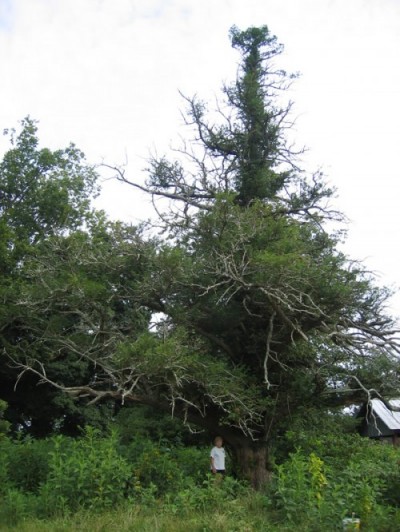
Florida torreya (Torreya taxifolia)
©Calvin & Judy Seaman
^http://www.dfr.state.nc.us/urban/tree_detail.asp?Tree_ID=210
According to the website ‘Hubpages.com‘ the tree the Florida Torreya (Torreya taxifolia) is the most endangered tree species in the wild in the world, and the other most at risk endangered trees around the world are:
African Ash
African cherry
African mahogany
African Teak
Afzella
Aja
Ajo
Alcerce
Almaciga
Argarwood
Bintangor
Brazilian cherry
Brazilian rosewood a.k.a.Dalbergia Nigra, Jacaranda da Bahia
Bleedwood tree
Ceylon satinwood
Egba
Guatemalan fir
Honduras mahogany
Ipe
Kauri
King William Pine
Lauan
Meranti
Molave
New Guinea walnut
Nayotah
Parana pine
Parlatorei
Pau rosa a.ka. Pau Brasil
Pencil cedar
Ramin
Red sandalwood
Rosewood
Sajo
Spanish cedar
Teak
Utile
Walnut
West Indian Satinwood
[Source: ^ http://hubpages.com/hub/Endangered-Trees ]
UNEP Official List of Endangered Tree Species:
According to the United Nations Environment Programme [UNEP], the world’s officially top twelve species of endangered trees are:
African Blackwood, which is also known as Mpingo in Swahili is considered to be the national tree of Tanzania, despite the fact that it is native to 26 African countries, ranging from northern Ethiopia, to the south in Angola, also spreading from Senegal across to Tanzania.
Mpingo not only improves soil fertility, but is also good at maintaining soil stability. Its leaves offer feed for migrating herbivores and for domestic livestock. The mature African Blackwood trees are capable of surviving fires that destroy other vegetation in grasslands. The dark heartwood of Mpingo, is one of the most economically valuable timbers in the world.
Bois dentelle is a beautiful tree, endemic to the high cloud forest of Mauritius. Despite the fact that it has no commercial value, only two individuals are left. The most remarkable thing about the species are the flowers – sprays of white bell flowers with fine lacy petals that cover the tree in summer (January -March).
The Clanwilliam cedar is a species endemic to the Cederberg Mountains in the Western Cape Province of South Africa. A majestic tree of 6-18 meters in height, the Clanwilliam cedar is a rot-resistant, fragrant and visually beautiful timber that was extensively exploited for building, furniture and later on telegraph poles by European settlers in the eighteenth century.
The Dragon Tree is found on the Canary Islands, Cape Verde Islands, Madeira and Morocco. The Guanche people of the Canary Islands used the sap for mummification purposes. In Ancient Rome, Sangre de Drago (Dragon Tree) was used as a colorant and across Europe it has been used as a varnish for iron tools.
According to the Greek myth, “The Eleventh Labor of Hercules: The Apples of the Hespérides”, the hundred-headed dragon, Landon, who was said to have been the guardian of the Garden of the Hespérides, was killed by either Hercules or Atlas in order to fulfill Hercules’ task to bring back three golden apples from the garden. As told in the myth, the trees known as ‘Dragon Trees’ sprung from Landon’s red blood, which flowed out upon the land.
The species is classified as being “Endangered” by Cape Verde, while it is identified as being extinct in the wild on Brava and Santiago where only planted specimens exist today.
The Honduras rosewood is found in Belize in Central America and produces timber, which is extremely valued on the world market because of its use in musical instrument production.
Since the Honduras Rosewood supplies hard, heavy, durable and very resonant timber, when struck, it gives off a clear, loud note and making it itself most highly valued in the production of orchestral xylophones and claves. It is also used to make thin covering for fine furniture and cabinets, , knife handles etc.
The Loulu is a palm endemic to the northernmost of the Hawaiian Islands chain with the most variety of plant species of any island in Hawaii. There are fewer than 300 individuals of the Loulu left, because of limited regeneration caused by seed predation by rats and pigs as well as competing plants.
The Monkey Puzzle is the National Tree of Chile. Nevertheless, there is at least of these trees in every botanical garden in Europe. Its local name is Pehuén and its existence has great historical and social importance to the people living in that area known as the Pehuenche, which means “people of Pehuén”. The seeds of the tree shape an important part of their diet.
The Monkey puzzle is also valued for its unique and natural beauty, which makes it an emblem of a national parks and provinces in both Chile and Argentina. The timber found from the Pehuén has a high mechanical resistance and moderate resistance to fungal decay, hence for its being used for beams in buildings, bridges, roofs, furniture, boat structures, thin covering etc. Monkey puzzle forests have been fast destroyed and degraded due to logging, fire and grazing.

Nubian Dragon Tree is found in Djibouti, Saudi Arabia, Somalia, Sudan, and Uganda and was once a widespread and abundant species.
It is one of the few species that can survive wide periods of drought in all parts of its scope, hence making it an important part of the desert ecosystem. The mature fruits of the Nubian Dragon tree are eaten and its sap and fruit may also have medicinal properties.
Pau brasil is the national tree of Brazil, making it have strong cultural links to Brazil’s social and economic history. The species is known for the dye extract taken from the heartwood, for which it has been exploited since 1501. Presently, the dye extract and its bark are used locally for medicinal purposes. Research is being carried out to find out whether the bark of this tree can be used as a cure for cancer.
Pau brasil wood is hard and compact, which is almost indestructible and was traditionally used to make hunting tools; commercially, it was harvested for use as a construction timber and in craftwork. It is also highly valued by musical instrument makers and still being exported for the production of bows for stringed instruments.
The various uses acquired from the Pau Brasil have made it target to extensive collection and export of the dyewood, resulting in the loss of large areas of forest and the enslavement of local people and later on the demand for its timber by bow manufacturers has contributed to a great loss.
Quercus hintonii, also known as Encino of Hinton (Hinton’s Oak), is endemic to Mexico. Some of the wood’s uses range from locally made tool handles, to beams and fencing poles, and primarily for firewood. Traditionally the wood is used to bake bread known as “las finas”, which the distinctive taste is brought on by the smoke.
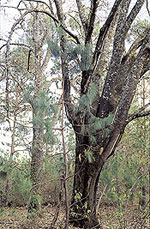 The species has also been highly affected by grazing, which prevents regeneration as well as the coming up of agriculture, coffee plantation and road construction have all contributed to the decline in the Quercus hintonii populations. The species has also been highly affected by grazing, which prevents regeneration as well as the coming up of agriculture, coffee plantation and road construction have all contributed to the decline in the Quercus hintonii populations.
“Hinton’s Oak, Quercus hintonii, is listed as Critically Endangered on the IUCN’s Red List of Threatened Species™. It is found in sub-montane to montane dry forest in Mexico. Hinton’s Oak has a restricted habitat and is thought to have strict altitudinal requirements. It has become threatened in recent years due to the serious destruction and reduction in size of its habitat.”
[Source: IUCN, ^http://www.iucnredlist.org/sotdfiles/quercus-hintonii.pdf
St Helena gumwood was selected as St. Helena’s national tree in 1977. The endemic floras of St Helena are not only of great biogeographical significance, but they are also home for equally rare and unusual animal species. The St. Helena gumwood is one of the fourteen most globally endangered and endemic tree species in St Helena. It is threatened by human presence and their use of the timber for firewood and building.
The Wollemi pine belongs to the ancient Araucariaceae species, thought to be over 200 million years old. Until 1994, the Wollemi pine was believed to have become extinct about 2 million years ago, but it was rediscovered in a gorge 150 km north-west of Sydney, Australia. There are less than 100 mature trees in the wild, making it one of the rarest species in the world. Because of this rarity, the Wollemi attracts a lot of tourism, which threatens its existence because of the therefore threatened by tourism, for it may be disturbed by human activities, also exposing it to seeds being trampled, compaction of the soil, the introduction of weeds and an increase in the possibility of fires.
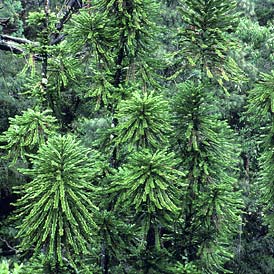
Wollemi Pine (Wollemia nobilis),
© J.Plaza RBG Sydney
[Source: UNEP, ^http://www.unep.org/documents.multilingual/default.asp?documentid=445&articleid=4845&l=en, accessed 28-Aug-10.]
IUCN categorisation of tree species at risk of extinction:
The International Union for Conservation of Nature [^IUCN] ‘criterion A’ requires that a subject tree species has a small wild population – less than 5000 individual specimens exist in the wild on Earth.
- A tree species will be determined to be Critically Endangered (of extinction) if there is expected to be at least 80 % decline in 10 years or 3 generations
- A tree species will be determined to be Endangered (of extinction) if there is expected to beat least 50 % decline in 10 years or 3 generations (Endangered)
- A tree species will be determined to be Vulnerable (of extinction) if there is expected to beat least 20 % decline in 10 years or 3 generations.
[Source: ^http://www.cites.org/eng/prog/criteria/1st_meeting/trees.shtml]
Further Information:
[1] Global Trees Campaign ^ http://www.globaltrees.org/
[2] Fauna & Flora International ^http://www.fauna-flora.org/
[3] Botanical Gardens Conservation International ^http://www.bgci.org/
[4] Guide to Endangered Trees ^http://ran.org/content/guide-endangered-trees-0
[5] Trees for Life ^http://www.treesforlife.org.uk/index.html
[6] Tree species evaluation using the new CITES* listing criteria ^http://www.cites.org/eng/prog/criteria/1st_meeting/trees.shtml
[7] WebEcoist ^http://webecoist.com/2008/09/13/20-unusual-threatened-forests-around-the-world/
[8] BBC article ‘Sherwood Forest ‘is under threat‘,5-Oct-07, ^http://news.bbc.co.uk/2/hi/uk_news/england/nottinghamshire/7029493.stm
[9] 1000 year old Major Oak, Sherwood Forest, Nottinghamshire, England ^http://www.eyemead.com/majoroak.htm
[10] The Tree Council (UK), ^http://www.treecouncil.org.uk/
[11] The Tree Council (Ireland), ^http://www.treecouncil.ie/
[12] Treasures of the Plant Kingdom, ^http://gardenwebs.net/plant.jewels.htm
[13] WollemiPine.com ^http://www.wollemipine.com/index.php
[14] Kew Gardens – Science & Conservation (England), ^http://www.kew.org/science-conservation/index.htm
*CITES stands for the ‘Convention on International Trade and Endangered Species of Wild Fauna and Flora‘
Did You Know that?
• ‘An area of a rainforest the size of a football field is being destroyed each second.’
• ‘The forests of Central Africa are home to more than 8,000 different species of plants.’
• ‘More than 5,000 things are made from trees such as houses, furniture, pencils, utensils, fences, books, newspaper, movie tickets even clothing and toothpaste.’
• ‘Three-quarters of the world’s people rely on wood as their main source of energy.’
• ‘In Ethiopia, between 100,000 and 200,000 hectares of forest are cut down every year. Still, at least 200 million people lack enough wood to cook their food properly.’
• ‘Destruction of forests creates numerous environmental catastrophes, including altering local rainfall patterns, accelerating soil erosion, causing the flooding of rivers, and threatening millions of species of plants, animals and insects with extinction.’
• ‘Tropical forests cover 23 per cent of the Earth’s land surface, but they are disappearing at a rate of 4.6 million hectares a year. Asia leads losses with 2.2 million hectares a year, Latin America and the Caribbean together lose 1.9 million and Africa loses 470,000 hectares of rain forest every year.’
• ‘About 6.1 million hectares of moist deciduous forest disappear every year, of which the largest regional share is in Latin America and the Caribbean, with 3.2 million hectares lost.’
• ‘More than 1.8 million hectares of dry deciduous forest disappear every year, 40 per cent of which is lost in the Sudan, Paraguay, Brazil and India.’
• ‘Annual losses of very dry forest total some 341,000 hectares. The Sudan loses 81,000 hectares of this type of forest every year, followed closely by Botswana, with 58,000 hectares.’
• ‘Global annual deforestation for desert forest stands at an estimated 82,000 hectares, 60 per cent of which is lost in Mexico and Pakistan.’
• ‘Hills and mountains lose about 2.5 million hectares of forest annually, 640,000 of which are lost in Brazil, 370,000 in Mexico, and 150,000 hectares in Indonesia.’
[Source: ^UNEP website ]
El Árbol del Tule

(Spanish for “the Tule Tree”) is a tree located in the church grounds in the town center of Santa María del Tule in the Mexican state of Oaxaca. It has the stoutest trunk of any tree in the world. In 2001 it was placed on a UNESCO tentative list of World Heritage Sites. In 2005, its trunk had a circumference of 36.2 m (119 ft), equating to a diameter of 11.62 m (38.1 ft). [Source: http://en.wikipedia.org/wiki/Árbol_del_Tule ]
© The Habitat Advocate Public Domain
|
|
 Smoking Ceremony or Smoke and Mirrors?
Staged for the delegates by National Parks and Wildlife Service of New South Wales (NPWS), somewhere outside Sydney, Australia
[Source: ‘Global First Nations environmentalists share stories at the World Parks Congress in Sydney.5:30’, ^https://twitter.com/nitvnews, 20141113]
Smoking Ceremony or Smoke and Mirrors?
Staged for the delegates by National Parks and Wildlife Service of New South Wales (NPWS), somewhere outside Sydney, Australia
[Source: ‘Global First Nations environmentalists share stories at the World Parks Congress in Sydney.5:30’, ^https://twitter.com/nitvnews, 20141113]
 Dredging the Great Barrier Reef for bulk export shipping
Dredging the Great Barrier Reef for bulk export shipping  Mass tourism operators good for the economy
Getting up close to protected Humpback Whales within their 100 metre Protected Area
Mass tourism operators good for the economy
Getting up close to protected Humpback Whales within their 100 metre Protected Area
 Protest to stop Queensland Resources Council dumping dredge spoil inside the Reef
Protest by Cairns and Far North Environment Centre (CAFNEC), June 2014
^http://cafnec.org.au/wp-content/uploads/2014/03/rally-promo-photo.jpg
Protest to stop Queensland Resources Council dumping dredge spoil inside the Reef
Protest by Cairns and Far North Environment Centre (CAFNEC), June 2014
^http://cafnec.org.au/wp-content/uploads/2014/03/rally-promo-photo.jpg
 White Lemuroid Possum
(Wet Tropics of Queensland World Heritage Area in Danger)
Has the white lemuroid possum become the first mammal to go extinct due to global warming?
White Lemuroid Possum
(Wet Tropics of Queensland World Heritage Area in Danger)
Has the white lemuroid possum become the first mammal to go extinct due to global warming?


 1927 ‘Black August’
When 600,000 Koalas were shot and skinned across Queensland
1927 ‘Black August’
When 600,000 Koalas were shot and skinned across Queensland



































































